▶
What
Adaptive
AR
▶
▶
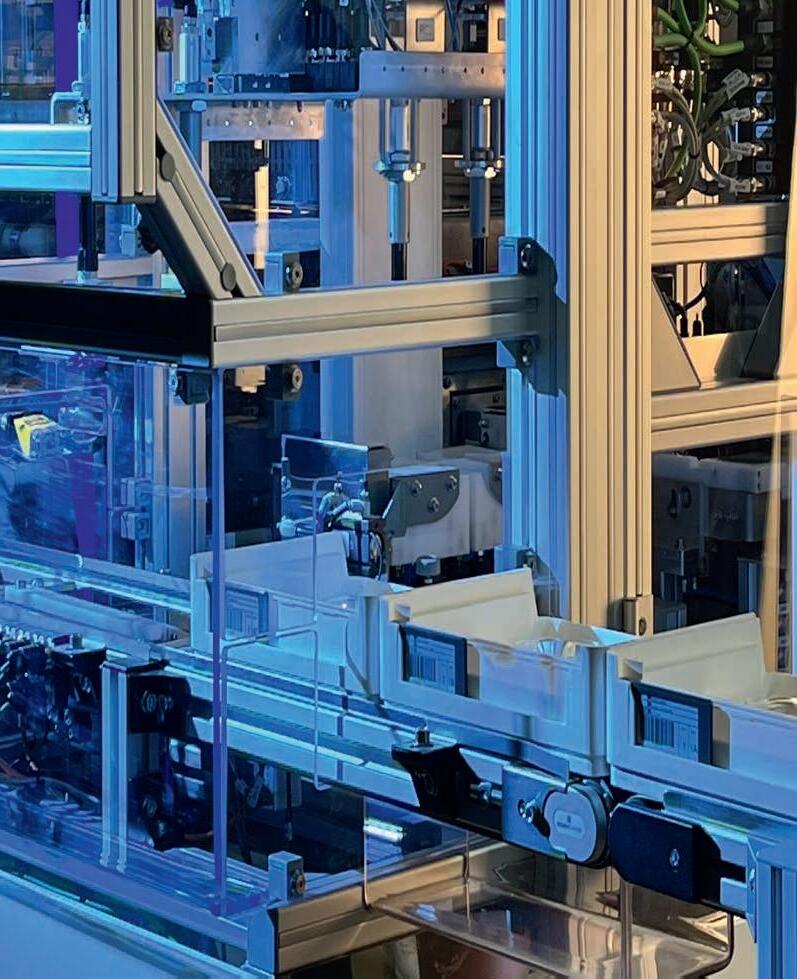
2/2024
Special topic: Smart Technologies
labs need to be successful in the future
smart glasses for future?
and MR devices as the next computing platform
Live on site
atmosphere at this year's MAFO –The Conference
2024back in force
- a successful start to the new optical year
Great
Mido
Opti
Market Surveys Industrial edger
Business Risk management strategic and structured ISSN 1614-1598 66527 Volume 20 OPHTHALMIC LABS & INDUSTRY Eyepress Fachmedien GmbH Saarner Str. 151 45479 Muelheim a. d. Ruhr 66527 Germany Connect, discover, stay up-to-date $ $ $
paperless and innovative digital solution converts traditional printed job tickets into a reusable and dynamic format allowing labs to update job information on the fly while retaining all the advantages of visual data. satisloh.com Instant visibility into real-time job status to make efficient decisions. DYNAMIC SUSTAINABLE SCALABLE Risk-free, step-by-step implementation as your needs grow. COST-EFFECTIVE Reduces lab operating expenses Reusing E-Ticket Tags, significantly reduces paper & ink waste STEP INTO THE FUTURE WITH DIGITAL JOB TICKETS E-TICKET SYSTEM BETTER THAN PAPER! Contact us to learn how the E-Ticket System can streamline your operations! $
▶
This







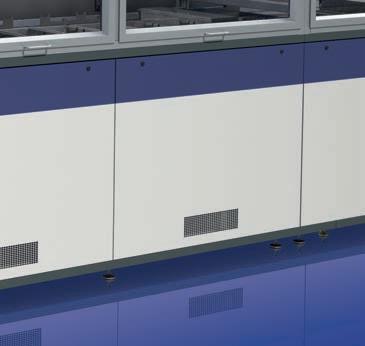
CHC200: The Choice of Leading Labs Worldwide.






Optimize your lab with the CHC200's cutting-edge dip coating capabilities, offering efficient cleaning and hard coating for up to 200 lenses per hour. Experience swift and flexible lens processing with two automated robotic systems. Achieve complete control and customization of the coating process through a user-friendly digital HMI for seamless operation.
The CHC200 comes fully equipped, providing everything you need to initiate or enhance your lens coating journey.

t: +44 (0) 1462 491616
e: sales@optimal-technologies.com
www.optimal-technologies.com

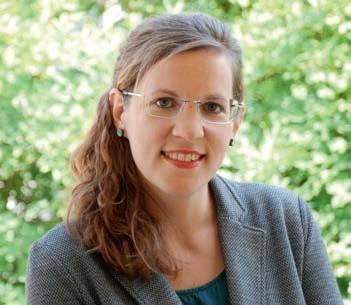
The euphoria is back
After several years of disruptions to international trade shows, followed by a slow return to normality, this year the European trade fairs Mido and Opti are finally back. High visitor numbers, lots of exhibitors, but above all an excellent atmosphere, were all very impressive. Mido reported record numbers with over 40,000 visitors in total, while the opti had 21,500 visitors – a significant increase on last year when around 15,500 people came to the event. After years of infighting and tussles about dates, locations and in some cases the absence of major exhibitors, the Opti now seems to have overcome the troubles of the past.
Incidentally, this optimism also applied to ‘MAFO – The Conference’ which MAFO itself organizes one day before Mido every year. This meeting point for the industry, with its insightful lectures on developments in the spectacle lens industry, was also better attended than it has been in years, with 90 participants – and most of them submittted extremely positive feedback.
Visitors are obviously excited to come to trade fairs and other events again, and are keen to discover new things. This maybe because there are a lot of interesting developments to get to grips with right now. Blockless manufacturing is a much-discussed topic both for machine and lens manufacturers that many labs are watching closely.
Other interesting new machines – especially for larger labs – include automatic cosmetic inspection or machines for unpacking blanks
automatically. But these are just a couple of individual examples. Things get really exciting when a lab introduces the latest technology at multiple levels. You can find out more about what such a lab looks like and about the advantages that smart technologies have to offer, starting at page 22.
Another topic that is currently gaining traction concerns lenses with variable refraction. The refractive index, for example, can be changed at the press of a button, or even using autofocus, and can thus correct distance or near vision as required. This technology is based on liquid crystal lenses (LCL).
Back in 2011, PixelOptix demonstrated glasses but was ultimately unsuccessful. This time round, however, things could turn out differently, as at least two companies already have products on the market and others are soon to follow. You can find out more about this topic in the detailed article starting on page 28.
And for everyone who likes to think outside the box, or is already putting out feelers to find out more about Augmented Reality (AR), Mixed Reality (MR) or Extended Reality (XR), turn to the article on page 34.
And finally – besides reading trade journals – be sure not to miss the upcoming trade shows, so you can experience the machines, processes and products at first hand. In March, the Vision Expo East is being held in New York for the last time, before it moves to its new home in Orlando as from 2025. Many visitors will certainly visit this last fair in New York with mixed feelings. But as the saying goes: When one door shuts, another opens.
us your opinion, ideas and suggestions: hanna.diewald@mafo-optics.com MAFO 2-24 3 LETTER
Hanna Diewald Chief editor
Tell



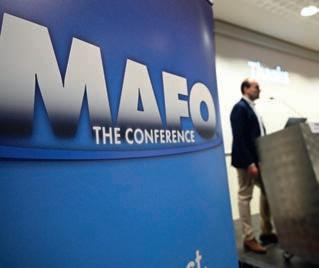


MAFO 2-24 5 MARCH / APRIL 2024 MAFO issue March / April 2024 Content Topics in this edition At a glance 6 All about you News from the international ophthalmic industry 7 All about markets Infographics 8 All about products Innovations and products for your lab 54 Suppliers Guide 48 Closing Words Carla Moncunill Cabré 49 Outlook Technology 22 What labs need to be successful in the future By Sandra Stry and Kim Kathrin Leidig 28 Adaptive smart glasses for future? By Lena Petzold 34 AR and MR devices as the next computing platform By Mandy Gebhardt and Matthias Nestler Live on site 10 Great atmosphere at this year´s MAFO – The Conference By Hanna Diewald 14 Mido 2024 ‒- back in force By Hanna Diewald Live on site 20 Opti - a successful start to the new optical year By Daniel Groß and Frank Sonnenberg Business 38 Risk management - strategic and structured By Russell Kenrick and Sidra Sammi Surveys 42 Industrial edging Page 10 Page 34 Page 38 Special Topic Special Topic Special Topic
All about you
News from the international ophthalmic industry
Steve Sutherlin to be honored posthumously with the 2024 Goodfellow Award

Steve Sutherlin will be honored posthumously with the 2024 Goodfellow Award during the Lab Leadership Forum on Thursday, April 11, and Friday, April 12, 2024, at the Temecula Creek Inn (Temecula, California). The Goodfellow Award is designed to recognize an outstanding individual who actively contributes to the advancement of the optical industry. Steve’s contributions to the optical industry are vast. He died of a heart attack on December 28, 2023. Steve was 70 years old and lived in Overland Park, Kansas. The optical laboratory executive was instrumental in the success of his family’s business, Sutherlin Optical, and later played a key role in merging the Optical Laboratories Association (OLA) into The Vision Council.
ANFAO introduces CSE (Certified Sustainable Eyewear)

The first international sustainability certification, CSE (Certified Sustainable Eyewear) was presented at Mido 2024. Created, registered, and promoted by ANFAO, the Italian Association of Optical Goods Manufacturers, in collaboration with CERTOTTICA, this certificate is destined to become the new product sustainability standard for the eyewear industry, certifying glasses and their components: frame fronts, temples, lenses, small metal and plastic parts. The certification identifies the most sustainable products, it is voluntary and based on UNI EN ISO 14020 and UNI EN ISO 14024 standards. It is open now to all eyewear companies, both Italian and international, who will apply for the program. The CSE label, issued by the independent body, CERTOTTICA, will be issued by ANFAO based on a number of industry-specific assessment criteria that take into account the entire life cycle of the product (resource extraction, raw materials, production, distribution, use and disposal).
Landmark event: final NYC show

Vision Expo East 2024, co-hosted by The Vision Council and RX, is on track to be a landmark event for the eyecare and eyewear industry worldwide. Over 450 eyewear and eyecare companies gearing up to display their latest products and technologies across an expansive 150,000 square feet of exhibit space for one final show in New York City, taking place from March 14-17 at the iconic Javits Center. But this show is also the end of an era. From 2025, the Vision Expo East will take place in Orlando, Florida.
Zeiss Vision Care acquires IP portfolio for electronic eyewear from Mitusi Chemicals

Zeiss Vision Care announced the successful acquisition of a comprehensive intellectual property (IP) portfolio, including a suite of patents, from Mitsui Chemicals. This strategic move solidifies Zeiss’ commitment to advancing technology in the eyeglass lens industry and further opens new opportunities for the development of electro-active lenses and spectacle frames. Modern eyeglass lenses can protect the eyes from harmful UV radiation, reduce perceived glare when driving, or reduce digital eye strain when working with computer screens. An innovative area for eye care will be the combination of electrically controlled functions with lenses and spectacles. The acquired IP portfolio comprises a range of groundbreaking patents that encompass various electric functionalities tailored for eyeglass lenses and frame electronics.
You have news for the ophthalmic industry? Submit your press releases to: hanna.diewald@mafo-optics.com or constanze.classen@mafo-optics.com
MAFO 2-24 6 INTERNATIONAL NEWS
All about markets
Graphical data
On average, in 2024, every person worldwide is expected to generate a revenue of USD 19.17 in the Eyewear market.
Source: https://www.statista.com/outlook/cmo/ eyewear/worldwide
The most spoken languages: on the internet and in real life

The global eyewear market size is expected to grow from USD 146.1 Billion in 2023 to USD 215 Billion by 2033, at a Compound Annual Growth Rate (CAGR) of 3.9% during the projected period.
Source: Spherical Insights & Consulting
It is estimated that in 2024, 85%
of sales in the eyewear market will be attributed to non-Luxury.
Source: https://www.statista.com/outlook/cmo/ eyewear/worldwide
MAFO 2-24 7 INTERNATIONAL NEWS
All about products
Innovations and working materials for your lab

MEI launches ClearXM
ClearXM, the innovative integrated solution developed by MEI for cleaning and inspecting eyeglasses edged lenses. It’s a very compact system that combines a loading system able to accommodate any shape of edged and uncut eyeglass lens with a cleaning section made of sealed chambers designed to avoid contamination. With the incorporated imaging technology, ClearXM scans and recognizes the contours and dimensions of the lens, ensuring a secure and precise clamping mechanism. By understanding the specific shape and size of the lens, the system can optimize the cleaning process and apply the appropriate pressure and movement patterns needed to effectively remove dust, smudges, or other particles from the lens surface while avoiding the risk of scratching or other damages. Additionally, ClearXM has the option of the integrated cosmetic control, which learns from each lens and auto-improves its performance continuously, without impacting the working cycle time. Visit www.meisystem.com
Awarded for innovative power!
Newly crowned innovation champion: SCHNEIDER GmbH & Co. KG from Germany has received the TOP 100 seal 2024. This German award is only given to particularly innovative medium-sized companies. SCHNEIDER convinced a team of renowned jurors, among them is a leading innovation researcher Prof. Dr. Nikolaus Franke (Vienna University of Economics and Business), in a scientific selection process. For the second time, SCHNEIDER has been selected as one of the top innovators (2014, 2024).
"Innovation is our corporate purpose," says Gunter Schneider, Managing Director and owner of the company. "Our vision was and still is to create a fully automated and intelligent 'Power Lab of the Next Decade' that increases efficiency and saves resources," says Schneider. Visit www.schneider-om.com


Horizons Optical Showcases Groundbreaking mimesys Office at MIDO 2024
Horizons Optical proudly announced its participation at MIDO 2024, held on February 3rd. The event served as the platform for the unveiling of mimesys Office, the latest innovation in lens creation technology. For the first time, users can craft their daily work environment to analyze gaze dynamics in their office setting. This breakthrough application allows for the creation of customized office lenses that not only address visual strategies but also study visual posture in front of screens, resulting in unparalleled visual comfort. With mimesys Office, users can expect a tailored approach to lens design that prioritizes both visual clarity and ergonomic comfort. This cutting-edge technology marks a significant milestone in the optical industry, offering users unprecedented control over their visual environments. Visit www.horizonsoptical.com or contact@horizonsoptical.com
Advertisement
Craft your workspace, Ensure your comfort
MAFO 2-24 8 INTERNATIONAL NEWS
Highest 3+
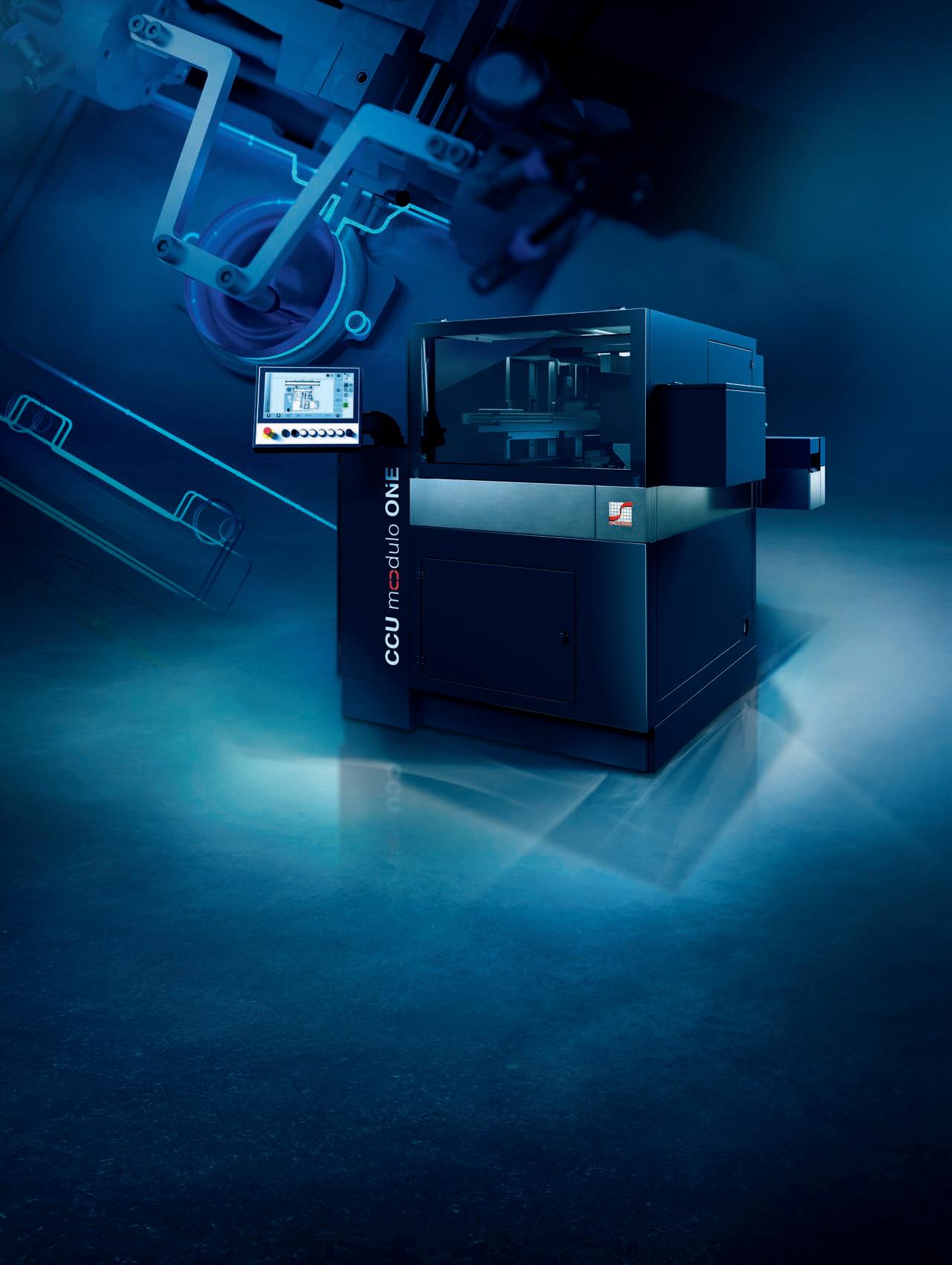
Little
CCU m dulo
Highest
One auto blocker covering virtually all of a labs’ blocking requirements at highest speed.
With CCU Modulo ONE, SCHNEIDER introduces the only auto blocker today with automated block size exchange and achieves unprecedented efficiency in blocking.
Time-consuming manual changes are a thing of the past. CCU Modulo ONE has multiple block sizes –a minimum of three and up to six – readily available. And the best part: The exchanges are carried out automatically and without increasing cycle time.
With the added flexibility, CCU Modulo ONE solves a well-known problem: Inefficient block size distribution and poor machine utilization. For any lab size, a wider range of blocking requirements can be met with a smaller number of machines.
The proprietary lens measuring unit guarantees perfectly oriented lenses. An intelligent fill control provides highly consistent and precise fillings – no under or over fillings. The alloy and block pieces can be refilled during operation.
flexibility
to no downtime
Non-stop uninterrupted blocking for highest throughput, at lowest cost per lens. throughput
www.schneider-om.com
BLOCKING PERFORMANCE AT A NEW LEVEL


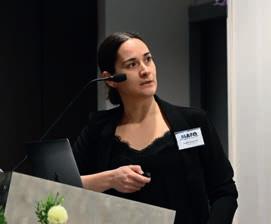
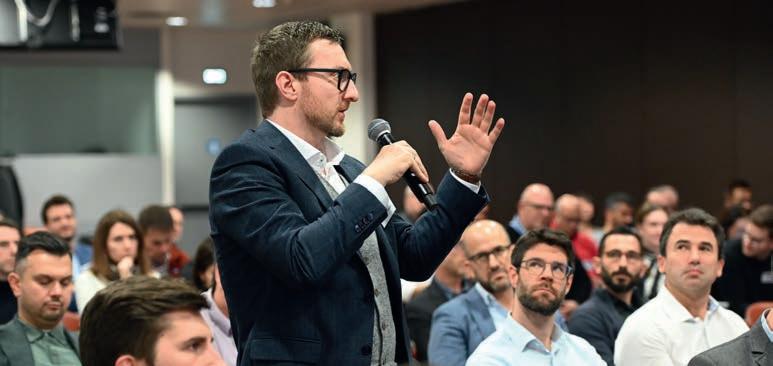


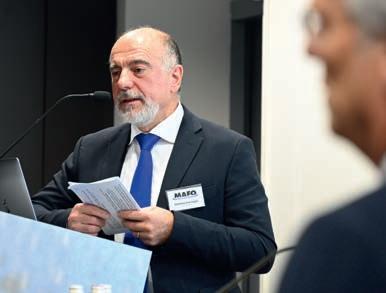
Great atmosphere at this year's MAFO – The Conference
Exciting topics and many participants in Milan
Smart Glasses, blockless manufacturing, myopia management and artificial intelligence – these were just some of the topics presented at this year's MAFO – The Conference. The varied program attracted visitors from all over the world, ensuring a record number of participants. By Hanna Diewald
90
participants from the global spectacle lens industry attended this year's MAFO – The Conference in Milan. The number of participants was thus considerably higher than in previous years and many visitors were enthusiastic about the exciting topics presented and the excellent atmosphere at the venue.
The meeting place for the ophthalmic optics industry in Europe
As usual, the unique meeting place for the spectacle lens industry took place the day before Mido, on Friday, February 2 in Milan. It brought together people from labs from all over the world, as well as representatives from machine manufacturers, lens designers, software developers
Smart Technologies
MAFO 2-24 10 LIVE ON SITE

and many other professionals involved in the development of ophthalmic lenses or who simply wanted to be up to date with the latest developments in the eyewear industry.
The event started at 8.30 a.m. with a welcome breakfast before participants gathered in the conference hall to eagerly await the first presentation.
This was introduced by long-term Chairman Peter Baumbach, who, as usual, led the audience through the program in an entertaining manner and – thanks to his wide experience in ophthalmic optics –repeatedly challenged the speakers with interesting questions.
Baumbach is Professor of Ophthalmic Optics and Psychophysics at Aalen University in Germany and is a sought-after expert for the calculation of spectacle lens designs, patent analyses and much more.
Spectacle lens analyses in a driving simulator
The first lecture by Dr. Judith Ungewiss from Aalen University (Germany) began very realistically with the topic: “Psychophysical evaluation of optical lenses in the Aalen Mobility Perception and Exploration Lab (AMPEL).” As spectacle-lens experts know, vision in a car at night poses particular challenges.
The risk factor for accidents increases significantly when driving at night – an aspect that should not be neglected when developing lenses.
Ungewiss presented the university's driving simulator, where vision while driving is simulated and analyzed in an Audi A4. The laboratory is also equipped with a steering and pedal unit, two projection units, 180° curved screen, a monitor behind the car and the SILAB simulator software. There are also different sources of glare, and the system has a CE certification.
Ungewiss explained convincingly how psychophysical tests are carried out under realistic conditions. For example, the assessment of halo areas (“halometry”), visual acuity and contrast sensitivity, with clinical examination methods and driving (at night) with and without glare.
And, of course, there is no shortage of fun and experimentation in the driving simulator: “We have found that people also enjoy trying out things that are not allowed!” Ungewiss said with a grin at the end.

Much discussed: blockless generating
The first blockless generator has been on the market for a few months now, so it is no wonder that labs are wondering how well the new technology works and what advantages and disadvantages it has. So it was good that two speakers gave presentations on this topic, to shed light on the topics from all sides.
Stefano Sonzogni from MEI System began with the topic: “The block-free lens generation process – an effective step ahead in preserving the environment ”
For Sonzogni, the advantages of the new technology are obvious: Without a block, there is no need for tape, no block, no alloy, no glue and, of course, no taper and no blocker or de-blocker.
This is sustainable, too, as it saves space, energy and entire process steps. Sonzogni also emphasized that thinner blanks could be used in the future, so that more than 60% residual material could be saved, as it will no longer be necessary to use thick blanks to avoid deformation during the alloy-cooling and solidification process.
Nevertheless, the head of the company made no secret of the fact that the current generator still has limitations, such as in curvature and working range; these were also addressed at length in the Q&As.
This lecture was followed by Dr. Michael Kreis from Satisloh on the topic of: “Opportunities and challenges of blockless surfacing technology” , shedding light on the same subject from a different angle. Satisloh makes no secret of the fact that they, too, are working on a blockless generator. However, it is still in the development stage and has not yet been deemed as market-ready due to certain limitations which still exist.
Dr. Kreis began his talk with explanations of what processes are currently available, and what tasks blocking in general fulfills. For example, the accurate positioning of a semi-finished blank in six degrees of freedom or holding the blank in position during processing is required; both to secure the position of the blank/lens in a tray when being moved as well as to support it during each and every manufacturing operation.
The machine manufacturer also emphasized the ambitious goal that new blockless generators should eliminate the existing operations of
Smart Technologies
MAFO 2-24 11 LIVE ON SITE
Smart Technologies
blocking etc. while still fitting 100% into an existing line. Thus the aim of the machine manufacturer is to offer the latest generator in a blockless version, and to adapt the polisher to suit the next operation.
Nonetheless, there still remain certain limitations: reduced working range, front and back curvature is restricted, limited range of materials, reduced throughput, non-rotationally symmetric surfaces like front side progressives cannot be handled, and a poor balance of the overall production line. According to Kreis, the technology therefore has enormous potential – but whether it can ever be applied to the entire range of ophthalmic lenses remains uncertain.
New data: “Plug-and-produce and create benefits!”
Data from machines is the basis for making Industry 4.0 possible in labs, but in order to really use and reuse it sensibly, common standards for labs and machine manufacturers are needed too. This was the subject of the talk by Dr. Jens Buergin and Heiko Schlump from Zeiss: “Connectivity as enabler for Industry 4.0.”
For the two experts, the motto for production is clear: “Plug-and-produce create benefits!” For this to work, however, some conditions have to be met: One keyword here is “connectivity.” This forms the basis for generating value from data and can be achieved by standard machine interfaces, for example.
One example is the standardized order-related data connectivity flow, compliant with the Vision Council’s Data Communication Standard (DCS). Also relevant here is the Open Platform Communications Unified Architecture (OPC UA) which offers potential for enhanced connectivity. It is the industrial communication protocol that has become the preferred communication standard in modern industries.
Automatic cosmetic inspection
Dr. Marcel Mahner from Schneider continued with a slightly different take on standardization in his presentation: “Empowering the Ophthalmic Industry through Artificial Intelligence – new possibilities on the example of cosmetic inspection”.
Inspecting every single lens by hand at the end of production, holding it up to the light to detect even the smallest defect and searching for

every flaw could become a thing of the past – at least for large labs. Thanks to machines that take over cosmetic inspection, defects should become easier to detect, classified and subsequently even avoided altogether. In his talk, Mahner explained exactly how this works and what role artificial intelligence can play in the process.
Standardization is an important keyword here, too, as it enables labs to be more objective and makes them less dependent on the subjective assessment of a person, which may vary from day to day. For this purpose, the first step after measurement is to carry out lab-independent pattern recognition with the aid of artificial intelligence. In the second step, a lab-specific quality standard evaluation based on certain quality criteria is carried out, which can be individualized. What kinds of defects occur, and whether these are specific to the location and how often they occur, are all relevant to determining the individual situation in each lab.
Disruptive technologies: additive manufactured optical coatings
The last presentation before the lunch break was about a completely new, unprecedented technology: “Going digital: How Additive Manufacturing (AM) will change the ophthalmic coating industry” by Jonathan Jaglom from the start-up flō.
The company is working on machines for labs that can be used to create e.g. photochromic coatings or colors using 3D printing, for example. This is intended to increase flexibility, as almost any design can be printed, because everything is controlled at pixel level. And, acccording to Jaglom, it is more sustainable as only the area that is actually needed can be printed.
Jaglom reported confidently that in the future, it should be possible to print as much of the lens as possible. He maintained: “We are very motivated to find a solution for AR coating and we have two directions how to get there.” However, Jaglom was not permitted to reveal any further details. The first three machines are due to be installed in US labs at the end of 2024.
During the break, the guests then gathered in the adjoining room for lunch and chat with others in a relaxed atmosphere.


MAFO 2-24 12 LIVE ON SITE
After lunch, the event continued with two sessions focusing on lens design and smart glasses – the latter discussed from two completely different aspects.
A myopia management design for every lab
José Miguel Cleva from IOT kicked off with an interesting talk on myopia management design that has also been corroborated by studies in the EU: “Revolutionizing Myopia Management – a novel approach to treating myopia in children”. The design is particularly exciting for labs, as there is no need to purchase semi-finished products.
After a brief introduction to the problem of myopia in general, Cleva explained the theoretical background to the Asymmetric Peripheral Defocus lens (MPDL) before going on to discuss the results of the study in Europe. The effectiveness of this lens for the treatment of myopia was investigated in the first randomized double-blind study conducted specifically in a European population. After a follow-up period of 12 months, the study showed a remarkable 39% reduction in axial length progression, which distinguishes this solution from conventional single-vision lenses.
The special free-form technology distributes the positive progressive lens power at the periphery. The free-form technology enables production using any material, so that no special semi-finished products are required.
Artificial Intelligence for spectacle lens design
The next lecture by Dr. Gaetano Volpe and Pasquale Fanelli from ProCrea Tech was also about lens design and how it can be improved with the aid of artificial intelligence: “AI and Neural Networks in Freeform Lens Design Software.”
After the experts had discussed the term “artificial intelligence”, and explained what neural networks and machine learning have to do with the topic, the second part of their talk dealt with the integration of AI into software for spectacle lens designs.
In short: It is possible to create an AI algorithm that, thanks to a neural network, guarantees the best performance of the progressive lens. The algorithm seeks to maximize output values (increasing customer satisfaction). And generative-type AI can also be applied to the development of progressive freeform surfaces. Research is leading to continuous development in this area, and the frontier is interesting as new relationships between variables could be discovered and further improve PALs.
Calculation: back to the roots
After this excursion into the future, the next presentation was more about going back to the roots. Because as great as the new technologies are, specialists still need to understand the basic principles that underpin the calculation of lens designs.
Mo Jalie from the University of Ulster, who has participated in MAFO –The Conference for decades, addressed the topic of “The Minimum Thickness of Spectacle Lenses.”
Step by step and accessible to everyone, Mo explained in his calm manner how to calculate the minimum thickness for a given prescription so that the thinnest and lightest lens for a given strength can be made in the appropriate material.
Electronic glasses with active optics
Unfortunately the penultimate speaker, Varsenik Nersesyan from Morrow, was unable to attend the conference in person as she was suffering from corona, so her presentation was transmitted via video link. Nonetheless, this did not dampen participants’ interest in her presentation, nor in the exciting topic itself: “Morrow Electronic glasses with active optics for vision correction.”
Her presentation was about electronic glasses that change their refractive power at the touch of a button, and can therefore be used for distance and/or reading correction. They correct sphere and cylinder and the possible addition value is 1dpt but the glasses are currently only available in Belgium. However, both availability and the amount of addition are expected to change in the future. The company would also like to collaborate with the industry and labs in the future because, as Varsenik Nersesyan made clear: “We don't want to sell our glasses in MediaMarkt, we want to sell them at opticians!” (MediaMarkt is a German multinational chain of stores selling consumer electronics). For more on this topic, see the detailed report about LCL lenses starting at page 28.
Smart glasses by laser cutting of high-index glass waveguides
In the final presentation, participants were able to immerse themselves in the world of AR glasses and learn about the challenges involved in their production. This presentation by Arved Kampe from 3D-Micromac brought the day to a very technical close. It was entitled: “Shaping the Future of Eyewear: How to create AR glasses by laser cutting of highindex glass waveguides.”
After an introduction to AR glasses in general – how they work and what components they require – the focus moved specifically to the processing of the waveguide combiner. In a joint project involving Schott and 3D-Micromac, the experts are working on a promising approach for scalable freeform glass cutting with high strength and precision, based on ultrashort-pulsed lasers. The experts perfected a laser-based separation process for achieving high and predictable bending strength in order to guarantee high production yields. This was then integrated into a modular machine concept, scalable from lab to mass production.
After being immersed in so much technology, new processes, innovations and much more input, the participants were finally given the chance to digest everything they had learned over a cocktail – or simply exchange ideas with other participants and speakers in a relaxed atmosphere –before heading back to the hotel in anticipation of their first day at Mido the next day.
The next MAFO – The Conference will be held on Friday, February 7, 2025, in Milan; as always one day before Mido.
Smart Technologies
MAFO 2-24 13 LIVE ON SITE




Mido 2024 - back in force
40,000 visitors in Milan
The Mido seems to be back. There were seven halls again and more than 40,000 visitors. Over 1200 exhibitors in seven pavilions and overall a great atmosphere. In fact, the world's largest optical trade fair was at its best this year and there were many innovations for the industry and labs. Read more about the most important machinery trends, designs and industry news in this report. By Hanna
Diewald
The terms trade fair and trade show are often used interchangeably. However, in the case of Mido, the term “show” clearly hits the spot, because this is about much more than just exhibiting products. At Mido, everything is art. Everything is creative. And everything is extraordinary. So it is easy to imagine that one extravagant frame followed the next among the frame newcomers. But also the machine area here always seems to be a little more exotic than that at comparable trade fairs. Anyway, it is one of the largest machine areas for ophthalmic optics in the world. The attraction of Mido is therefore assured.
After the event, the organizers proudly reported that there had been 11% more visitors than last year, with visitors coming from all over the world – from Asia to the United States and all over Europe. The figure of 40,000 visitors is impressive, even though Mido once hosted 59,500 visitors in pre-corona times. But, of course, as is so often the case, quantity does not always have much to do with quality. In addition, social channels reached 50% more people than last year and the media coverage is also worth mentioning: after all, 400 accredited journalists attended the show, publishing reports throughout the world. The Mido 2024 | Digital Edition, with nearly
Gunter Schneider from Schneider in front of the auto blocker CCU modulo ONE.
Laurence Vaudolon and Hajo Follert at the AGP booth.
Giovanni Spreafico from MEI System in front of the ClearXM.
MAFO 2-24 14 LIVE ON SITE
Picture:
MIDO

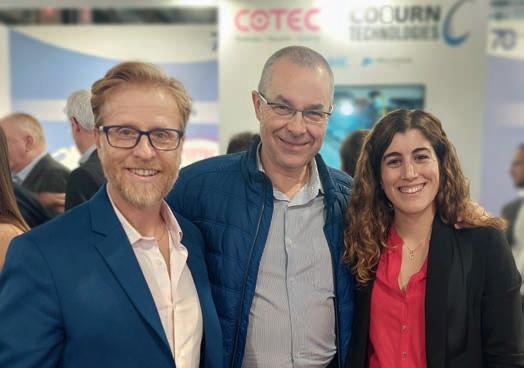



12,000 subscribers, saw an increase in showcase pages, up from 650 in 2023 to 845 this year, thus highlighting the extent to which exhibitors increasingly consider it advantageous to combine in-person participation with virtual activity.
As usual, the focus of interest for MAFO was Hall 6 and 4. This is where (almost) all the machine manufacturers, but also lens designers, software developers and many other companies associated with lens manufacturing are located; and all the major names are to be found here.
One trend in particular has recently become very apparent: the automation of every process step in the lab that was previously carried out manually. This applies to automatic cosmetic inspection, the automatic unpacking of blanks, automated storage options for blanks and the seamless integration of cleaning machines into the line without lenses having to be touched.
70th anniversary
This year, Cotec , the thin-film coating technology company, and machine manufacturer Coburn Technologies shared a joint stand; both are part of SCL. Coburn Technologies has a special anniversary this year: the company is celebrating its 70th birthday and it did so in style at Mido. Their stand was not only packed during the official celebration but also on the remaining days as well.
Among other innovations, the machine manufacturer presented the new Nexus DGT generator. The generator is characterized by faster
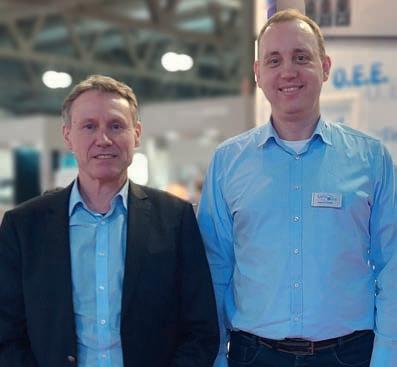
No lab functions without good software. Bernd Freyermuth and Andreas Schmitt from LensWare were happy to inform interested visitors about their offerings.
processing and higher throughput, auto calibration and on-board engraving of semi-visible marks. The Nexus DP digital lens polisher is designed for high-volume production of freeform Rx lenses and can process 80% of the product range using a single soft tool.
Also on display was the CrystalCrome, a photochromic spin coating system. A unique machine that enables the production of photochromic lenses on demand, rendering semi-finished photochromic blanks obsolete.
Automated cosmetic inspection and deboxing
Holding lenses up to the light in order to inspect them with eagle eyes and scanning them for even the smallest defect may become a thing of the past. At least a number of machine manufacturers are currently working on this.
One of Schneider's highlights was the CSI Module ONE, a machine for fully automated cosmetic inspection. The system uses AI-based pattern recognition. On first step a pattern is recorded with a camera. In step two, the system makes a cascaded defect-specific evaluation. In the final step, a lab-specific quality standard evaluation is carried out, based on specific quality criteria. This solution detects cosmetic defects fully automatically with absolute reliability. Also on show was the new deboxer DBX Modulo ONE, capable of unpacking any common kind of box – cardbox, blisters, even sleeves – in
F.l.t.r.: Alex Incera, César Collazo (SDC) and Carla Moncunill Cabré at the Coburn Technologies and Cotec booth.
Coburn Technologies celebrated their 70th anniversary.
Steffen Runkel and Johanna Vistbacka at the Bühler booth.
At Comes visitors could see a whole range of machines for the production of spectacle lenses.
MAFO 2-24 15 LIVE ON SITE
a highly efficient and eco-friendly way. Unpacking is done by levering open the box ‒ without the need for a laser, etc.
Visitors were also able to see a further step on the way to more automation in the LCU Modulo ONE. The fully automated in-line unit is now equipped with automatic ticket transfer. This means that job tickets can now be transferred fully automatically from the surfacing tray to the coating, without the need to transfer the tickets by hand. And, of course, many more machines were on display for visitors to inspect.
Rx-Bot-LUKE, a new brush cleaner and the latest generator
This time, the Satisloh Group stand brought together Satisloh, SCL International, DAC Vision and Ultra Optics , now all part of the Satisloh Group.
Visitors to the stand saw the Rx-Bot-LUKE, for example. The system, now on the market, unpacks semi-finished lenses. The robot takes the lens boxes, opens them, unpacks them and sorts them, putting the waste into separate bins and placing the lenses back into the job tray for further processing – all without human intervention.
Visitors could also inspect the new Hydra-Brush-4, a fully automated compact and water-efficient soft-brush cleaner for the fronts and backs of ophthalmic lenses as well as the new e-ticket system, which replaces paper tickets and therefore has the potential to make labs completely paper-free. The VFT-orbit-2i, the manufacturer's latest digital lens generator, is


now on the market and has already been successfully installed. It works with AI and machine learning for predictive maintenance. There was also a technology previous to be seen: ACI-Theia for automated cosmetic inspection. The machine, sealed against dust, is designed for automatic detection of defects and is expected to be able to process 300 lenses an hour.
Another technology previous was the NEO-edge, a next-generation industrial blockless edger for standard and complex shapes, characterized by extremely high processing speeds and unmatched versatility.
A strong partnership
At Bühler Leybold Optics visitors to the Mido were the first to learn about the new partnership between the coating experts Bühler and the cleaning experts FISA. Now customers can look forward to perfectly matched processes and an expansion of the Bühler product range in the future. In addition, Bühler is now offering the Boxer series in all sizes with more energy-efficient pumps.
Automated cleaning
Automation all along the line that is the focus at FISA . Here, visitors saw the fully automated ultrasonic cleaning machine FISA Inline CS, used for cleaning lenses after surfacing, polishing and deblocking. The machine is flexible and can meet all demands: tape, alloy or protective coating residues, all indexes and more. Two collaborative robots, in
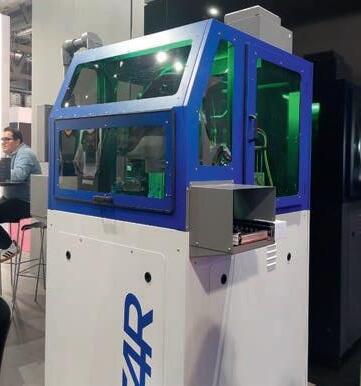


 François-Charles Laberge and Hugh McAllister from K&Y Diamonds.
The Ocuco booth attracted many visitors.
Jared Snow and Christian Tuss from Satisloh in front of NEO-edge.
The FISA-team at their booth f.l.t.r.: Matteo Rasi, Bernat Casaramona, Francesco Bertoja, Philippe Vaudeleau, Riccardo Strizzi
The company Ultra Optics presented their fully automated spin coating machine 54R.
François-Charles Laberge and Hugh McAllister from K&Y Diamonds.
The Ocuco booth attracted many visitors.
Jared Snow and Christian Tuss from Satisloh in front of NEO-edge.
The FISA-team at their booth f.l.t.r.: Matteo Rasi, Bernat Casaramona, Francesco Bertoja, Philippe Vaudeleau, Riccardo Strizzi
The company Ultra Optics presented their fully automated spin coating machine 54R.
MAFO 2-24 16 LIVE ON SITE
Many visitors at the OptoTech stand party.
the beginning and the end of the machine for loading and unloading, allow the integration in the production flow. The machine is Industry 4.0 ready, contains Wifi, Power Line Communication (PLC) via low voltage, ethernet remote connection, camera and sensors that measure all data in the baskets such as temperature etc. The machine is also equipped with a user-friendly MCU (Machine Controller Unit) with Open Platform Communications (OPC).
Brush cleaning and cosmetic inspection
MEI System proudly showcased a new technology that is expected to be available on the market as from next month. The ClearXM combines automatic edged lens brush cleaning and cosmetic lens inspection in one machine. The combination reduces the footprint, avoids contamination on the way to the next station and enables handling of both edged and uncut lenses. As the machine scans the contours, cleaning is particularly efficient and the cosmetic inspection is carried out on a completely clean lens.
Visitors were also able to see the final version of EasyBuddy, the robotic arm that feeds the EasyFit Trend lens edger. EasyBuddy can manage up to five trays at the entrance and five at the exit. It supports the option of adding an automatic stacker/ destacker system or connecting external conveyors, to further increase production autonomy. Orders can either be prepared via the LMS, an offline station or directly at the machine. And, of course, the blockless generator was also on display. The CoreTBA is a blockless freeform lens production system. For the first time ever, the blockless system allows laboratories to avoid the use of tapes, blocks, wax or alloy. Furthermore, the machine does not require a water filtration system thanks to its dry-cut technology. CoreTBA combines seven stages of the production process in a single device, e.g. digital generation, engraving, polishing and washing.
Lens inspection
At Automation & Robotics , visitors could see inspection equipment for a wide range of applications. From the ProMapper table-top inspection device to the AutoMapper for larger labo ratories, which performs automatic inspection for any type of lens, power measurement (ISO/ANSI compliant) and mapping inspection (error maps).
A particular highlight, however, was the presentation of the NeoMapper. A technology previous that is set to gain traction in the future, particularly thanks to its very small footprint and many interesting characteristics such as automatic inspection of every type of lens. This inspection feature includes precise and automatic positioning, inspection of geometric properties such as thickness, diameter, shape, optical power measurement, polarization axis measurement, power mapping of the entire
PHOTOCHROMIC SPIN COATING SYSTEM
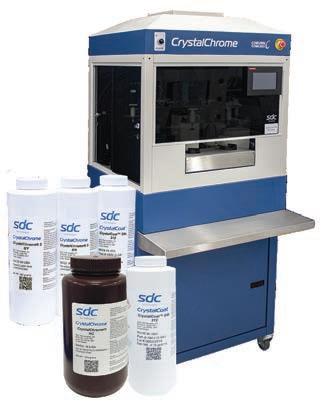
• Best-in-class photochromic performance on all lens materials
• Fast darkening and fading speeds
• Compatible with anti-reflective and metalizing treatments
• Fast drying thermal cure
• Photochromic coatings suite from SDC Technologies

Advertisement
MAFO 2-24
INNOVATIVE NEW PRODUCT
1-800-COBURN-1 See our full line of products at coburntechnologies.com Vision Expo East Booth F2435
lens surface (error maps) and uploading of the measured data for preventive maintenance and troubleshooting.
AR-coating and cosmetic inspection
Machine manufacturer OptoTech also held a stand party at the Mido which proved very popular. The company presented its brand new OAC-90 AR-coating machine, which has a significantly reduced cycle time and a new ergonomic design. In addition, the pumping and cooling system ensures a lower cost per lens.
The manufacturer has also recently added the VISTA to its range, a machine for automated lens inspection that detects all known cosmetic defects with maximum precision and speed. Other machines that contribute to full automation in labs include the De-Boxer, a machine for automatically unpacking semi-finished blanks, as well as the IQ-Star intelligent storage and distribution solution which enables automated job tray handling.
Printing, new designs and much more
In addition to the many machine highlights, there was of course plenty else for visitors to discover: Innovative eyewear fashion, news from the lens manufacturers and much more. For example, Rodenstock is positioning ColorMatic as an independent technology brand with a specific brand design. This means that Rodenstock is now giving independent lab partners access to the ColorMatic technology and brand. IOT presented MyoLess, an optical solution designed to effectively address childhood myopia. Backed by advanced technology and a study conducted

on a European population, MyoLess offers a 39% reduction in axial length growth in children. Furthermore, IOT presented a comprehensive international campaign for Neochromes, its flagship line of photochromic lenses.
Horizons Optical showcased mimesys Office. For the first time, users can now craft their daily work environment to analyze gaze dynamics in their office setting. This application allows the creation of customized office lenses that not only address visual strategies but also study visual posture in front of screens.
TECO presented its new X-Cube DECO to print permanent logos on the lenses. The machine facilitates the printing of glossy, satin or matt multicolored logos, with impressive rendering and very good scratch resistance. The company is now proud to offer two printers for decoration: the X-Cube DECO to print permanent logos on lenses and the X-DTS DECO (Direct-To-Shape Robot) for permanent printing of logos on lenses and frames. Both models use fully ecological inks.
And EssilorLuxottica presented a preview of Nuance Audio, a product embedding hearing technology seamlessly into eyeglasses. It is expected to launch in the second half of 2024.
There were also many exciting specialist presentations and news announcements at Mido. For example, the new Sustainability CSE certificate and the Empowering Optical Women Leadership Program and much more to experience. The next Mido will take place in Milan from February 8 to 10, 2025. Thus, there will be just a few days between opti in Munich and Mido in Milan.

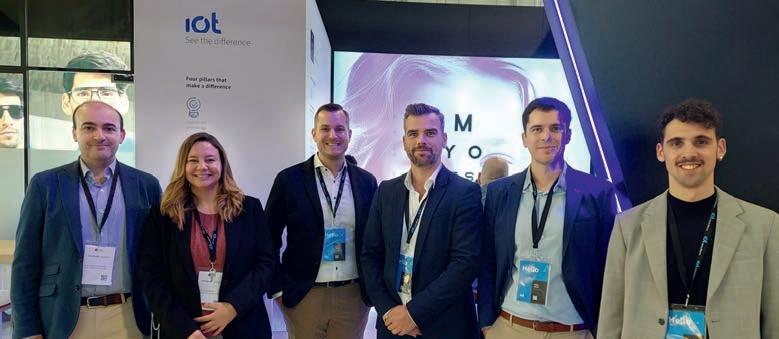

 The General Optics booth in Hall 6.
Rupert Katritzky from the RAX Group in front of a storage solution for spectacle lenses.
F.l.t.r.: Thomas Zangerle, Sandra Fonticoli and Laurent Provost in front of the automated lens inspection NeoMapper.
At the teco-booth visitors could experience the new X-CUBE DECO to print permanent logos.
The General Optics booth in Hall 6.
Rupert Katritzky from the RAX Group in front of a storage solution for spectacle lenses.
F.l.t.r.: Thomas Zangerle, Sandra Fonticoli and Laurent Provost in front of the automated lens inspection NeoMapper.
At the teco-booth visitors could experience the new X-CUBE DECO to print permanent logos.
MAFO 2-24 18 LIVE ON SITE
The IOT team at its booth. F.l.t.r.: Jose Miguel Cleva, Alicia López, Ivan Sincek, Javier Trujillo, Carlos Muñoz and Eder Granado.

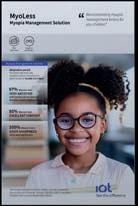




See the difference Discover how collaborating with us can revolutionize your operations. www.iotlenses.com Contact our Sales Team! New ground-breaking technologies and discover our groundbreaking portfolio of lens designs with a brand new suite of marketing materials. Visit us at Vision Expo East 2024 Stand F2625 Your lens design and innovation partner Try Neochromes, our latest photochromic lenses Embrace the light A completely new suite of marketing materials IOT Digital Ray-Path 2 Steady Plus Methodology Camber Technology Steady Methodology

A successful start to the new optical year
Opti in Munich 2024
For some it is an important order fair, for others a platform for personal contacts and customer communication vis-à-vis. It is also often referred to as the kick-off event right at the beginning of the new (optical) year. Whichever group you belong to: Opti 2024 in Munich (Germany) in mid-January once again attracted significantly more interested parties than in previous editions, and whetted the appetite for more. Why might that be? Let us take a look at it. By
Daniel Groß and Frank Sonnenberg
New Opti = new optical year. That is what we are used to in Europe. And so this January in Munich (Germany) it was once again a meeting with familiar faces, but also new, promising players from the world of ophthalmic optics. After all, a trade fair should also offer the opportunity to look beyond the horizon. And it succeeded. So much in advance. It was packed at the entrances right from the start and many exhibitors had plenty to do at their stands, especially during the core times on Saturday.
Strolling through the four well-attended exhibition halls, however, it was noticeable right from the start of the fair on the first day: people
are in the mood for trade fairs. A desire to see, touch and test. Over the course of the day and especially on Saturday, the day with the most visitors, business was already in full swing. This is exactly how we experienced the Opti this time, after somewhat quieter post-corona editions recently.
The „who is who“ of the industry
From the major frame suppliers to independent companies and hungry newcomers with new products and innovative processes, the trade fair covered the entire spectrum. Shopfitters, equipment and software manufacturers, ophthalmic lenses (trade fair comeback
MAFO 2-24 20 LIVE ON SITE
of industry giants Zeiss and Rodenstock in Hall C4), equipment suppliers, opticians' associations and contact lens companies etc. all came to Munich.
Only the machine manufacturers for industrial ophthalmic lens production were hardly represented – here only individual companies such as Schneider and MEI Systems held their own. However, the principle of „see and be seen“ seems to apply again to Opti.
This positive trend is also reflected in the number of visitors: 21,500 participants contributed to well-filled order books, new contacts and an optimistic mood at the start of the optical year. A veritable increase compared to last year's trade fair, which attracted 15,500 visitors.
The number of exhibitors also made a big leap from 307 exhibitors in 2023 to 390 exhibitors from 28 countries at this year's edition.
Information and food for thought
Several „hubs“ also contributed to a lively, informative trade fair this time. These are areas that bundle important questions and trends from a specific subject area in order to impart specialist knowledge and give the audience new impetus for their own work.
Located next to the “Innovation Area“, Selin Olmsted, for example, took the audience on her journey through the optical trends for 2025 (Trend Hub). Industry experts also provided new input in presentations and discussion rounds on myopia management and sustainability, and the topic of careers was not neglected either.
As part of the Career Hub, there was also a scavenger hunt (campaign initiated by Oculus: „On the trail of knowledge“), in which invited master students and students from universities and colleges of ophthalmic optics visited exhibitor stands and tested their specialist knowledge.
A campaign that attracted a large audience, „Lens in focus“, which used iris photography to draw attention to the topic of contact lenses, should also not go unmentioned here.
Meeting point: sustainability hub
What is happening in the optical industry when it comes to sustainability? Over the three days of the trade fair, visitors to the sustainability hub supported by FOCUS (MAFO's sister magazine) were able to see for themselves how industry representatives passionately discussed topics such as the recycling of demo lenses and contact lens blisters, the avoidance of microplastics and the sustainability responsibility of the industry and opticians.
Individual aspects were also explored in greater depth in presentations. One highlight was undoubtedly this year's Sustainability Award, which was presented for the first time at the Sustainability Hub for particularly sustainable ophthalmic optics companies.
Three finalists were selected from all the submissions, all of them medium-sized companies, who competed against each other in a pitch lasting several minutes for the prize money of € 5,000. They had to present their ideas on sustainability in the three key areas of economy, ecology and social issues. In the end, the winner was Andreas Schmidt from Augenblick Brillen Kontaktlinsen GmbH.
From the industry for the industry
Universities and aid organizations are also represented at Opti with their own areas. This is where members meet, make new contacts and bump into old friends and supporters.
The organizer himself explains how it was possible for key industry players to pull together and, compared to previous years, to put their own vanities aside, when he emphasizes that the discourse that took place in the run-up to the event was crucial to its success.
True to the „We are Opti“ motto. „The close cooperation and the development of a joint concept with all trade fair stakeholders over the course of last year was crucial to the success. It's great to see how the Opti community loves its trade fair and believes in it – it was the sense of community that made this success possible!“ said Cathleen Kabashi, Exhibition Director of Opti.

Whether the Opti would have found its way back on track without this new approach after the inconsistencies and challenges of recent years, which in all fairness were not just home-grown, is something we will not and need not know. And that is a good thing.
The next Opti will take place in Munich from January 31 to February 2, 2025. However, Mido in Milan is just one week later, which is likely to be a challenge for many exhibitors and trade fair organizers in the coming year. But perhaps the motto „competition stimulates business“ will also apply here - we will see in 2025.
MAFO 2-24 21 LIVE ON SITE
The Sustainability Award, which was presented for the first time at Opti 2024 and comes with prize money of € 5,000, attracted particular attention.

What labs need to be successful in the future
8 points that constitute the power-lab of the next decade
The economic trend in the ophthalmic industry is obvious: Due to demographic changes associated with rising demands and new markets, there is a continuing request for more. At the same time, labs are confronted with an immense cost pressure. Labs are trying to meet these demands for higher throughput and reduced costs per lens while striving for unique products. However, in the face of a shortage of people and rising costs, this is not easy. Labs’ spendings must be reasonable, and investments need to be future proof. But what constitutes a lab that will work for them in the future? Not just the implementation of automation and a continuous improvement of machines. A future lab requires smart solutions, artificial intelligence, and more. Simply put: a system that works for you. By
Sandra Stry and Kim Kathrin Leidig
Imagine a power-lab, built on intelligent systems, that makes smart decisions on its own – an integrated system with the intellectual power to work for you. What once was a vision, today sets the benchmark for an ophthalmic lab 4.0. Intelligent machines and integrated solutions solve many problems of the past, when lab managers and their teams still worked manually to keep the production running. Back then, all core elements like lab management systems and machines, production management and conveyor systems as well as quality inspection were not integrated. Missing communication and insufficient
integrated workflows made the whole production dependent on the expert’s constant action, observation and cutting out the errors. Supervising the whole production process was hard, troubleshooting often painful and time consuming. The overall processes: not as efficient as they could be. Needless to say, a lab manager’s workload was continually high, and it might have felt like always being behind, chasing the process. Fortunately, this has changed for the good. Integrated systems can now work for you and make the whole work shift easier to control. Once installed, a real future lab will streamline and simplify the lab managers’
Smart Technologies
MAFO 2-24 22 TECHNOLOGY
life, and completely change his or her role in the lab towards more strategic decision taking. By boosting productiveness and efficiency of the overarching process, economic aims will become achievable. This future lab exists. So, what does it take to make smart lab management happen and benefit from this new production era?
1. Working smarter:
Innovation for economic growth
The first key aspect of a power-lab (editor's note: power-lab is a brand name of the Schneider company) remains high-end machines: To lower the production costs of each job, increased investment utilization is important, as well as reduced labor costs.
High-end machines tackle this need and can be seen as a vital investment to remain competitive today and in the future. “We understand that only best in class machinery will equip labs for rising demands and cost pressure by ensuring high throughput of lenses per hour, while saving resources,” says Stephan Huttenhuis, Vice President Technology at Schneider. “If you look at generating for example, the newest solution in the market achieves up to 50 percent higher throughput than previous generations – at the same footprint.”
This is important since smallest footprint becomes a major requirement because space is highly limited in many locations. Another example for improvements are the latest cleaning solutions with radically reduced equipment size that save precious production space. Many labs today also opt for centralized swarf management to save space.
Another opportunity to look for is time savings: smart machines that are more integrated and cover several steps in one, or run steps in parallel, improve lab productivity by saving precious time. In the best case, functionality even reduces the number of machines – which again saves space and money. This is possible with highly versatile blockers that can switch block rings or edging machines that work with four processing stations at the same time.
Huttenhuis: “Our new generations of machines are always designed to meet the major market needs; with the investment our customers put in, they simply get more results – or save money.”
2. Holistic optimization: System wide
Knowing that every second counts, to date machines have always been optimized for speed. Faster. Faster. And once again faster. But can simply improving the machines by their speed and performance be enough progress?
The company Schneider came to the crucial point that it requires more to cross the line of a new era; and instead of focusing on individual machines, they decided years ago to concentrate on more holistic and systematic approaches: Their vision is to create a fully-automated lab – hands free with intelligent solutions.
This strong vision has been realized with the Modulo system, which combines machines, measurement systems, accessories, and conveyors in one single, intelligently interlinked unit. The cognitive machines manage the production flow fully self-sufficient.


This avoids inefficiencies between machines or processes, e.g. jobs waiting to pass a production bottle neck, causing immense time delays and ultimately production losses. “We observed very often that in many labs the machines worked nicely, and the process was good, but not the overall workflow,” says Gunter Schneider, President at Schneider. “That’s where we saw great potential: Tackling those inefficiencies would definitely boost efficiency.”
One can say that this systematic approach was designed to leverage lab work to a new level, leading to an overall balanced workflow and workload. Today, it allows fluent processes e.g. from surfacing, to coating to edging.
New systems in the making will automate and integrate the coating process to streamline overall production. A potential alternative to batch coating, the current go to solution that causes a significant slowdown of the overall flow. “An integrated system accomplishes smoother production and makes the most of all resources and capacities. The highest machine utilization possible means taking full advantage of what you have got. Still, maximizing productivity isn’t everything, instead we want to offer solutions that really help the people who work with our system.” concludes Schneider.
Smart Technologies
Fig. 1: New technologies minimize non-productive times – e.g. HSE Modulo QS that is equipped with 4 work stations and performs multiple finishing steps simultaneously.
MAFO 2-24 23 TECHNOLOGY
Fig. 2: System wide instead of individual optimization is the key for dramatically increased throughput, machine utilization and cost per lens.
Smart Technologies
3. Built-in intelligence and communication
The most modern systems are now equipped with top-notch intelligence. This helps a lab manager to become less dependent on having the right people at the right time – one of the scarcest resources nowadays. This will be ensured through smart machines with cognitive features utilizing the Internet Of Things (IOT) including sensors and software, fluent communication between all core elements of the system and throughout all processes as well as efficient and transparent data analysis, reporting and visualization.
A smart machine knows its own condition at any time. Far beyond the current process, it knows all the details e.g. the status, consumable wear and lifetime, processing parameters etc. It knows every factor that might have an impact on product quality, consumption of resources and ultimately lab performance. It will constantly report and can be benchmarked against goals.
And most importantly, it will immediately provide information on critical aspects. This helps the lab manager to intervene as quickly as possible to tackle an occurring problem and prevent machine downtime. This way,


troubleshooting can be streamlined and taken care of much faster. Lowest harm for productivity equals lowest stress for the lab manager. Communication systems make sure that the overall workflow is clear and transparent at any time. Far beyond the processes within single machines, a smart system always knows what is happening. To do so, every machine checks their jobs “in” before the process starts and checks them “out” when it is finished. The overarching systems scan all this data and condenses it to become actionable information. It will process the data to support reasoned decision-making as it provides all relevant information at a glance. No more time-consuming walks around the production hall needed, just to check and see if things are running smoothly.
All smart components combined realize the great vision to build a smart organizing intelligent system, managing the production flow by itself, based on smart algorithms. This supersedes an old, rigid system; with operators telling machines what to do. The whole process changes from pre-planned job routing to condition based, in-situ routing. Saying that, now the system works out the best flow by itself – better than any single person could. The result: No more bits and pieces, but a comprehensive network of machines exchanging information.
4. Utter transparency facilitates better decision making
With all this data sourced, great new options come about. Future labs will want to make good use of this information giving rise to Management Execution Systems (MES), that provide lab managers with a transparency into their production as has never been seen before. An MES like the Schneider Modulo Control Center is a key tool to help lab managers to supervise and control the production in real-time and handle all tasks and priorities. It provides insights into the overall lab performance 24/7.
“In fact, it serves all the key positions in the lab – lab manager, quality manager, line driver and service manager – with relevant information,” says James Monaghan, Senior Director of Lab Operations at National Vision Inc. The MES seamlessly interacts with the intelligently interlinked machines, conveyors, and support systems to capture and analyze real-time data:
▶ Machine status
▶ Utilization factors like Overall Equipment Effectiveness (OEE)
▶ Quality/Breakage
▶ Tool lifetime
▶ Root cause analysis
• Error recognition
• Error prevention
▶ Statistical error analysis
▶ Routing options
With this, the lab manager will receive a new role in the lab ‒ a much more strategic one. He or she e.g. will be able to better determine when maintenance is due and how and when it is best carried out, decide about tools and lifetimes based on the operation results and assess
 Fig. 3: Smart systems rely on built-in intelligence and communication to manage the production flow more efficiently than any pre-planned model..
Fig. 3: Smart systems rely on built-in intelligence and communication to manage the production flow more efficiently than any pre-planned model..
MAFO 2-24 24 TECHNOLOGY
Fig. 4: Lab managers have all the information they need at their fingertips to make smart and strategic decisions with a modern MES system that monitors and controls the lab.
whether it is possible to take the next order or not – whole production shifts and ranges can be planned more thoroughly. Lab managers can even handle priority orders for their customers without hesitation.
On the digital management cockpit, the lab manager can keep track of all data to understand the current lab performance, the throughput of different machines, and how well the capacities of the machines were being used.
The operator can see – in real-time and well-structured– if there were any interruptions or failures that need to be controlled, adjusted or fixed. Data sourcing and advanced analysis provide deeper insights and feedback.
5. Trouble shooting at the next level
Big data might be a buzzword that in some context overpromises advancement. However, the smart MES proves how data can really make a difference: Especially, the error recognition is a game changer for lab managers, compared to how annoying troubleshooting used to be in the past. “Before the smart system, this equaled the work of detectives: sequentially tending from one error to the following, digging deeper to find its origin,” says Monaghan: Whereas the MES tackles the underlying big error straightaway. This prevents aftereffects, production losses and time-consuming analysis.

6. Self-Sustaining
Monaghan concludes: “In a nutshell: It delivers the shortcut to immediately solving the problem at its roots, while the lab manager does not waste time on investigating and chasing one error after the other. Moreover, with trend recognition a MES system can initiate counteractive measures before a severe problem arises.”
Latest versions can even calculate the cost per lens – a valuable strategic advantage for the economic and financial management.
When it comes to the organization of tasks, priorities and maintenance, a smart lab will help to establish new agile structures and adds remote solutions – easing daily business. Helpful tools like a Computerized Maintenance Management System (CMMS), allows scheduling, the procurement of parts and personnel planning.
It provides a comprehensive picture of what needs to be done. It shares instruction manuals – video tutorials or PDF handbooks – or supports reactive maintenance to make sure that the user receives real time support from the supplier. In interactive sessions, any specific questions or issues can be handled. Downtimes are being prevented with this software.

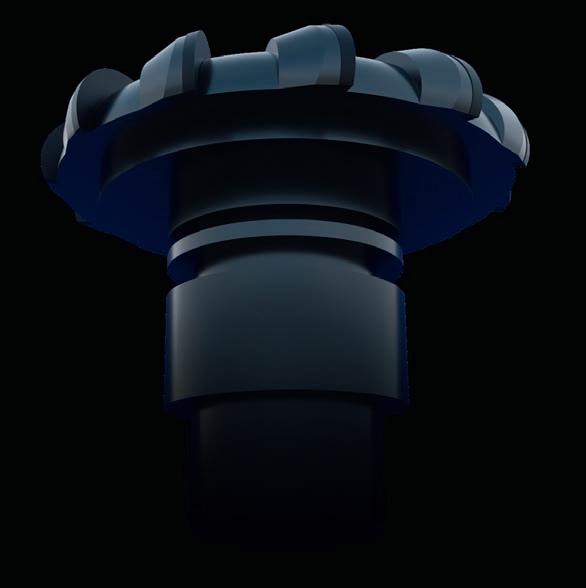

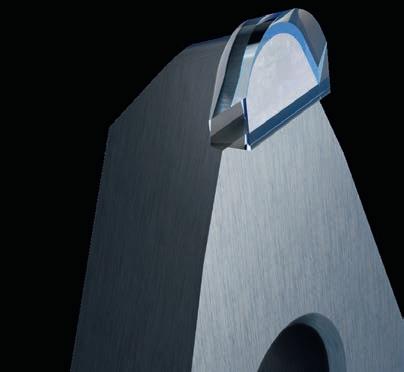

Smart Technologies Advertisement
TECHNOLOGY SPECTACLE LENS TOOLING ky diamond.ca ULTRA PRECISION DIAMOND TOOLS FOR ANY GENERATOR EXCELLENT SERVICE QUICK TURNAROUND
Fig. 5: Advanced modules like the cost tracking in Schneider’s Control Center allow for real-time cost control and production value offering unprecedented insights into financial aspects.
Smart Technologies


7. Modular system for continuous evolvement
Just like the bricks and stones of a Lego system, the modular Modulo system can be arranged easily in different ways, building a unique future lab. There is a standard arrangement, but with the easy extension possibilities there are many possibilities and options that can be used to arrange the lab exactly to the individual needs. It is possible to install such a lab from zero or convert an existing lab. Important to mention that it is conceived to be a lab that stays relevant in a given structure and can „grow“ and become better.
“As a very elaborated standardized system, with easy to install modular options – that does not require widespread reconstructions – it is a highly flexible system that can be easily extended. A real high performing power-lab is never a static condition, it means continuously optimizing lab production for the future market, handling resources, and serving the demands of the market,” Schneider says.
New machines on the market, such as the automated deboxer or AI-based cosmetic inspection, can be added simply to the modular system. And if the lab-layout needs to change to meet higher production requirements, the modular loop allows rearrangement or the addition of the machines in any order.
Schneider summarizes: “Modulo can show its full potential as an integrated system – still, the machines also work individually. We wanted
labs to have the option to switch step by step, or let their dream-lab rise over time, following a systematic approach.“
8. No future without sustainability
There is no denying – when it comes to climate protection things have to change. Economic enterprises have huge potential to help form these changings. As in any other producing sector, an ophthalmic power-lab has to reflect this need to save resources.
Modern state-of-the-art machinery can build the foundation for this value: Schneider shows efforts e.g. with innovative lens protection, where a small amount of UV-cured lacquer film protects the lens instead of conventional tapes and thus eliminates a high amount of plastic waste. Also, the deboxer that supports recycling of lens boxes by separating waste materials.
More holistically, the implementation of a smart lab dramatically reduces breakage thanks to early error recognition. By preventing breakage, resources for reproduction can be saved completely. In addition to waste reduction, also power consumption and resources such as water in the washers are being minimized with every new generation of machines.
A real power-lab continuously works towards that goal to have clean and resource saving production and low waste – for our future on this planet.
Fig. 6: A future-proof lab will increasingly rely on artificial intelligence solutions, e.g. fully-automated cosmetic inspection systems that reliable detect defects and assess overall quality.
Fig. 7: A high level of integration and smart communication is key to a holistic perspective that may boost overall lab performance and factors in every element of a lab’s daily business.
MAFO 2-24 26 TECHNOLOGY
The conclusion of a power-lab
Many words to say what a future lab is since it has many faces. Most importantly, it is a smart and complex system that facilitates operating cycles and creates seamless workflows to improve lab work and serves the operators. An average lab can be run by one lab manager, who has highest control over resource management, lab productivity and thus the lab’s profitability.
A power-lab allows high productivity and reduces complexity where needed. Fewer steps cause fewer errors, therefore creating machines, processes, and

Sandra Stry holds a PhD study of physics from Heinrich-Heine Universität, Düsseldorf, Germany. She started her career as project engineer at her alma mater and worked as head of R&D at Sacher Lasertechnik, n-Sigma Microsystems and PHIcom before joining Schneider in 2011 as senior project manager. Since 2019 she is the head of project management at Schneider.
communication as simple as possible evens the path for great achievements. No unneeded waste of energy – neither the energy of people who work there nor unnecessary energy of the machines in operation. Digitization and remote services leverage lab management to a modern era with fast ability to react on new parameters and circumstances. This changes labs in many more aspects than just higher cost-effectiveness. Lab managers can follow their own strategic vision to lead their lab to economic growth. The results: improved working conditions, best products, highest competitive advantages. ◆

Kim Leidig has a master’s degree in literature & media studies. As professional multimedia storyteller in a content marketing agency, she made scientifical subjects more tangible for the public. As project manager and marketing consultant, she helped her customers in developing unique strategies. In 2023, she joined Schneider as marketing specialist and journalist.











Smart Technologies
Kim Kathrin Leidig
Sandra Stry
TECHNOLOGY Advertisement 704 & 705 SILICONE DIFFUSION PUMP FLUIDS 617-227-1133 • 800-743-17 paula@filtech.com www.filtech.com SCAN FOR OUR FULL CATALOG QUAL SAVINGS FROM STOCK QUAL SAVINGS FROM STOCK QUALITY& SAVINGS FROM STOCK IONIZATION, THERMOCOUPLE & INSTRUTECH CONVECTION GAUGES INFICON RATE/THICKNESS CONTROLLERS & MONITORS

Adaptive smart glasses for future?
The innovation of liquid crystal technologies in spectacle lenses
When your arm gets longer and longer after the age of 40 and the words in the newspaper seem to get smaller with every issue, it is time to take a look at the natural ageing process of the eye. With advancing age, changes in vision occur, particularly in the near vision range. Presbyopia affects everyone at some point and experts believe that more than one billion people worldwide have presbyopia and that the number will continue to rise in the future. Ground-breaking progress has been made in recent years, particularly in the field of spectacle lenses with liquid crystal lenses. The term smart glasses can be used for adaptive optics as well as for microcomputers integrated into spectacle frames, which can be used to communicate, take pictures or even navigate. This article, gives a brief insight into the developments of adaptive optics, the corresponding structure of liquid crystal lenses and the resulting benefits in practice. By Lena Petzold
Presbyopia
But first the basics ‒ what is presbyopia? Presbyopia is a progressive loss of near vision. It is caused by the lens of the eye, which is part of the optical apparatus. Usually, the lens can change its curvature and its refractive power due to its own elasticity, so that objects can be recognized sharply both at a distance and close up.
Over the years, however, the natural ageing process of the eyes continues. In this context, the flexibility of the lens is reduced, and it becomes more rigid, which in turn leads to a reduced ability to accommodate. Once this happens, a visual aid is required. However, there are various types.
Options of visual aids
Contact lenses are one option for correction. In addition to single vision and multifocal variants, these are also available as monovision so that
objects can be recognized both close-up and in the intermediate range as well as at a distance. According to the latest findings, an alternative option is orthokeratology lenses, which can create a multifocal effect of the cornea when worn at night.
Another group is (refractive) surgery, which includes intraocular lenses, intracorneal rings or laser surgery. The disadvantage is that precise centering is necessary during the operation, as the changes to the cornea are irreversible.
With the aim of reducing the disadvantages of previous correction options, research is currently being carried out into drug therapy for presbyopia using various eye drops.
But by far the best-known correction option for presbyopia are reading glasses, which are available on the market in single vision, multifocal and progressive versions. The disadvantages of these spectacles are reduced visual acuity in the intermediate and very near ranges. In
Smart Technologies MAFO 2-24 28 TECHNOLOGY
addition, very precise centering of the spectacles in relation to the optical axis of the eye is necessary. Progressive lenses in particular can lead to a severe limitation of the field of vision, while this can occur with reading glasses due to the spectacle frame.
In this context, various companies are researching the development of liquid crystal lenses in order to minimize or eliminate the disadvantages through innovative lens designs. At least two companies already have such glasses on the market and others are working on them.
History of liquid crystal lenses
The liquid crystal was first described in 1888 by the Austrian botanist Friedrich Reinitzer. He observed that cholesterol benzonate melted at a heat of 145.5 °C (≈ 294 °F), but in a cloudy composition. If the temperature was increased by 30°C (≈ 86 °F), its appearance changed abruptly to a clear melt. He thus recognized that the cholesterol benzonate molecules in the cloudy phase had a certain arrangement that was responsible for the light-scattering properties.
100 years later, C. W. Fowler and E. S. Pateras reported on the use of liquid crystals in spectacle lenses to change the refractive power of the corrective lens. Liquid crystals have undergone remarkable development, particularly in recent years, for example in the (smartphone) camera and spectacle glass industries.
In the early 2000s, a team led by American scientist Tom Krupenkin developed one of the first liquid lenses. Internationally, these are known as liquid crystal lenses (LCL). Liquid crystals represent the mesophase of a material in which the properties of both liquids and solids (crystals) are at work. For this reason, the state of order of these substances is often referred to as a fourth state of aggregation.
Beginning in 2009, the company PixelOptics became well-known in the industry as many trade journals reported on it. In 2011 the company launched the product emPower! ‒ the first electronic focusing prescription eyewear. The patented technology was developed by PixelOptics and Panasonic Healthcare. However, the company filed for bankruptcy in 2013 and the patents were later bought up by Mitsui Chemicals [1]
In February 2024 Zeiss Vision Care announced the successful acquisition of a comprehensive intellectual property (IP) portfolio, including a suite of patents, from Mitsui Chemicals. This strategic move should solidify Zeiss commitment to advancing technology in the eyeglass lens industry and further opens new opportunities for the development of electro-active lenses and spectacle frames. In 2022 Zeiss Ventures has invested already in Morrow, a high-tech start-up from Belgium developing autofocal glasses (find out more about Morrow on the following sections).
Adaptive lenses today
Research to date has laid the foundation for today's goal of fast, uncomplicated and customized adaptation of visual acuity to environmental conditions without the occurrence of aberrations or the need to change glasses.
Adaptive lenses are spectacle lenses that can change their focal length under the influence of an external stimulus such as a magnetic field,
thermal effect or electrical voltage. The functional principle of liquid crystal lenses can be roughly divided into two different principles - the two-phase lens and the single-phase lens. What both variations have in common is that there is liquid in the center of the lenses.
Two-phase (lyotropic) liquid crystals
The first principle is based on two-phase (lyotropic) liquid crystals. Two immiscible liquid media, such as oil and water, are placed in a chamber. The liquids should have the same density, but different refractive indices and reactions to electrical impulses.
The chamber can be created by a cavity within a spectacle lens. At rest, the two media are balanced next to each other. When an external stimulus (e.g. electrical voltage) is applied to the surface of the chamber, the electrical field within the chamber is modified. This changes the contact angle between the two media and the orientation of the liquid crystal molecules.
This results in a change in the curvature of both media in the chamber, which in turn leads to a change in the focal length of the lens. This method can be modified by a deformable membrane so that liquids that are miscible can be used.
Single-phase (thermotropic) liquid lenses
The opposite principle involves single-phase (thermotropic) liquid lenses. The structure of these lenses is based on liquid crystals, which are enclosed in a thin layer between two transparent electrodes. By applying an electrical voltage, the molecules can be aligned in a defined manner, thereby changing the refractive properties and thus also the focal length of the lens.
eProgressives by Morrow Eyewear
The Belgian company Morrow Eyewear describes its liquid crystal lenses as “eProgressives”. This development won the 2023 Silmo d'Or award in the field of vision. In 2023, the Silmo d'Or honored creative and innovative developments by companies in ten different categories with two additional jury prizes for the 30th time. The categories deal with lens designs, frame designs adapted for children or sporting activities and examination devices for measuring the eyes.
The Belgian manufacturer's lens design is described as “proprietary lens-in-foil technology”. The lens consists of electrically variable liquid crystals, which in turn are based on Fresnel lenses. The refractive power of the polarization independent lens is changed by applying a low power electric filed.
The eProgressives should be seen as an alternative to multifocal optics, which impair their wearers due to insufficient visual ranges. Morrow's development was supported by imec, a Belgian research center for nano- and microelectronics, and the Belgian-Japanese lens manufacturer Tokai Optecs.
With the glasses' press-bottom control, a brief touch on the temple changes the focus setting of the lenses. Using the liquid crystal-based
Smart Technologies
MAFO 2-24 29 TECHNOLOGY
Smart Technologies

lens an optical boost of 1.0 diopter is added to the passive progressive and meets the final prescription of the user.
The lenses have an anti-reflective coating and a hard coating. They also feature a CE certification and an IP68 water protection rating. IP68 certification means that the device is both dust- and waterproof. In this context, waterproof means protection against continuous immersion in water up to a maximum depth of 1.5 meters for a maximum of 30 minutes. However, the company primarily emphasizes resistance to rain.
The lens technology is divided into two setting options. In the OFF state, a clear field of vision is provided in the distance and intermediate zones. This provides additional comfort for everyday activities such as driving and shopping. So far, so familiar.
Improved vision in the intermediate range is a result of the elimination of the restricted focal channel in conventional progressive lenses or the lack of sharp transitions between focal planes in bifocal lens designs. In this context, objects can be recognized in the intermediate area in the lower part of the lens - but almost across the entire width of the lens.
Another advantage of these lenses is the improved depth perception. The well-known multifocal effect should be reduced by the lenses, as there are no demarcated areas of vision. In this context, there is also no need to search for the correct head position to recognize writing at the desired distance.
Moreover, reduced peripheral distortion of the special lens design is a great benefit compared to regular progressive lenses. This means that sharper images can also be achieved in the peripheral areas of the lens, resulting in a larger field of vision.
The ON state of the eProgressive lenses changes the focal point of the lenses from distance to near - within 0.6 seconds. The wide reading range of around 24 mm and the associated limitation of the aberration zone results in a high level of reading comfort and a lower risk of aberrations occurring. As a result, the eyes and the brain have to process fewer different image impressions, which in turn reduces susceptibility to dizziness.
Furthermore, both the contrast and the precision of the lenses are increased by reducing aberrations. The area of the lens design for near vision extends to the center of the prescription lens. In the upper area, objects in the distance or in the intermediate range can still be recognized at the same time.
The effective range of the lenses is between -6.0 and +4.0 diopters with a maximum addition of +4.0 diopters. Astigmatism is also corrected in the prescription lens.
The average autonomy of the glasses is around two days, depending on the use of the different modes. In continuous OFF mode, the glasses' battery lasts for up to two weeks; in continuous ON mode, it only lasts for eight hours. The battery is fully recharged within 30 minutes. But what happens if the battery is completely empty and no charging option is available? Then the system automatically goes into fail-safe mode, while the glasses are fully functional in OFF mode, according to the manufacturer, as the optical boost is deactivated.
32°N by DeepOptics
A further development of liquid crystal lenses can be traced back to the Israeli start-up DeepOptics, which launched the 32°N liquid crystal sunglasses with variable focus on the market in 2021 in cooperation with Fielmann. In this context, the investment company Fielmann Ventures has acquired a 10 per cent stake in the start-up.
Deep Optics CEO Yariv Haddad emphasises the “advantages of the joint development of the glasses”, as his company's employees contribute in-depth technological know-how and product development expertise, while Fielmann contributes its far-reaching understanding of customer needs with ophthalmic expertise.
The first innovation from the collaboration is a pair of sunglasses that can be converted into reading glasses at the touch of a button on the temple. The 32°N glasses achieve dynamic focus via pixelated liquid

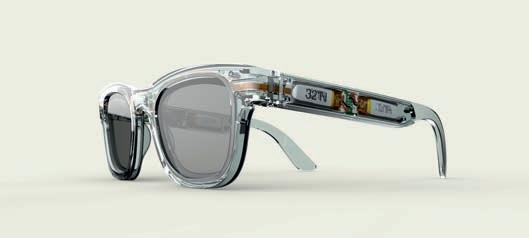
 Fig. 1: Progressive smart glasses by Morrow feature a user-friendly interface with simple touch-button control.
Fig. 1: Progressive smart glasses by Morrow feature a user-friendly interface with simple touch-button control.
MAFO 2-24 30 TECHNOLOGY
Fig. 2: The DeepOptics 32°N sunglass model is already on the market in the USA. Source: DeepOptics

crystal lenses. Millions of pixels form the so-called liquid crystal layer. The orientation of the crystals in the layer can be varied, depending on the distance at which a sharp image is to be generated.
However, this alignment does not happen by itself, but by applying a voltage. The voltage in turn is triggered by the wipe change or pressing a button on the temple. This results in either a diffusing or focusing effect with regard to the optical power of the lenses. Based on the setting variants, a distinction can be made between “scene mode”, which was developed for seeing at a distance, and “reading mode” for close-up work, such as reading a menu.
As shown in figure 3 the liquid crystals for scene mode (distance) are all parallel to each other, without any tilting of the individual lenses. The more the crystals are tilted in this case, the more the incident light is refracted, so that the focal point moves closer to the lens. This shows that the setting for reading mode includes both parallel lenses and lenses rotated by 90 degrees.
The inter-pupillary distance (IPD) is also measured for these glasses to ensure an exact fit. The closer the object to the eyes, the lower the IPD. In addition, the distance between the centers of the active lenses is also checked.
Optical Excellence:
Advanced Protection:
Flawless Coatings: Optimized technology for minimal defects


Smart Technologies Innovations for a better world.
augmenting the future
Smart Glasses –coating solutions
Cutting-edge equipment for complex optical filters
In-vacuum
hard-coat as a lacquering alternative
Contact us to elevate
leyboldoptics.virtualtour@buhlergroup.com Step into a sharper future with Bühler Leybold Optics
your vision:
Advertisement TECHNOLOGY
Fig. 3: Angle change of the microlenses in the spectacle lens for focussing on an object at different distances.
Smart Technologies


According to the manufacturer, the magnification range of the lens can be individually varied between 0 and 2.5x. The lenses also have an anti-scratch coating, UV protection and polarization filters. The total weight of the sunglasses is said to be around 45 grams.
The aim of the start-up is to adjust the dioptric effect and control the glasses via an app that can be operated using a mobile phone. This should be available in both the Google Play Store and the App Store. The plan so far is to offer a paid subscription in the app.
The innovation was first presented at the Consumer Electronics Show (CES) in Las Vegas in 2022. In the same year, this development received the “Best Innovation in Style” award from “Time Magazine”. On the official website of the Israeli company, the glasses are available in the colors black, caramel, brown and a transparent version, in which the technology behind the glasses can be seen, for around 849 dollars. 32°N glasses are currently only available in the US. The glasses will be showcased at Vision Expo East in New York.
Laclarée
The third company in this group is the French start-up Laclarée, launched in 2016 by founder Bruno Berge, who started the technological development
of adaptive lenses. Laclarée develops autofocus eyeglasses. Presbyopic people will be able to retrieve a fluid, natural and always acute vision. This project combines knowledge and experience from the fields of physics, materials technology, optics (vision science) and business administration. The first prototype was created after just two years of research. Based on this, 2019 the company received a seed funding in the total amount of 2 million euros to continue development. Two of the most active seed capital investors, Kreaxi from France and High-Tech Gründerfonds (HTGF) from Germany, are involved in this funding. The first trials of the development were carried out on around 40 presbyopic subjects with the CHU St-Etienne (Dr Trone, Pr Gain, Dr Thuret, France) to check the relevance of the design. According to the company, the feedback was very good. Ophthalmic retailers, ophthalmologists and experts from the optical industry also had the opportunity to test the lenses for functionality. Once again, all those involved agreed that the lenses should be used. But how do these spectacle lenses work? On the one side, they differ from the designs from Israel. The lenses from the French start-up consist of four different layers. The two outer, clear layers represent a regular unifocal lens design. These contain the dioptric correction values and have additional layers, such as a hard layer.
Add = +0D Add > +0D Add 0 = +0D Add1 = Add 0 Add2 = Add1 Rest position Pumping out Pumping in Rest position Pumping
out
a) Plano configuration
b) Curved configuration
Fig. 5: Lens adjustment modes for a) the flat mode and b) the curved mode.
MAFO 2-24 32 TECHNOLOGY
Fig. 4: (l) The lens can be tried out in a trial-frame to test the vision comfort provided by the autofocus lenses. (r) This is how the first glasses of Laclarée should look like in the future. Source: Laclarée
The two middle layers form a central doublet lens, which has a diameter of around 20 millimeters. These layers in turn comprise two liquids with different refractive indices. Both are separated from each other by a deformable membrane. The introduction of additional liquid leads to a change in the curvature of the lenses, allowing the focal length of the lenses to be varied. The higher the volume in the high-index layer, the more positive the effect (Jarosz et al., 2019).
The liquids of both layers can be pumped into or out of the center of the lens via two microfluidic actuators with a low power of a few mW. In addition to the opto-fluidic actuator, the glasses are completed by 2 ToF laser sensors on each side of the eyeglass pair. These sensors are evaluating the distance to the object being viewed. The result is then used to derive the required volume of the two liquids inside the lens.
The prototype takes around 1 second to change focus between the different distances. According to the company, all components of the glasses are compatible with a wide range of spectacle frames, meaning that the glasses can be customized to the wearer's individual needs. A detailed description of the lens prototypes can be found in the publication by Jarosz et al. from 2019 [2]
The product should be launched on the market by the end of 2025, at small scale with the seed funding. However, the company is still working on raising funds to accelerate the scale-up, with the goal of supplying to optical retailers in industrial quantities. The latest release of the company is a trial-frame for opticians. Their customers will be able to test the vision comfort provided by the autofocus lenses, and then sell the pairs. The final product will get commercialized in 2025.
There are currently several further companies researching and developing liquid crystal lens technology. The topic is also expanding to include intraocular- and contact lenses [3]. Whether certain existing designs will prevail or completely new developments will dominate the market remains to be seen in the future. So far, there is great potential around the topic presbyopia, paving the way for a wide range of innovations. ◆
References:
[1] https://www.visionmonday.com/latest-news/article/newly-formed-mitsui-subsidiary-to-revivepixeloptics-electronic-eyewear-1, current from 14.02.2024
[2] Jarosz J, Molliex N, Chenon G, Berge B. Adaptive Eyeglasses for Presbyopia Correction: An Original Variable-Focus Technology. Opt Express 2019;27:10533-52.
[3] Syed IM, Kaur S, Milton HE, et al. Novel Switching Mode in a Vertically Aligned Liquid Crystal Contact Lens. Opt Express 2015;23:9911-6.
 Lena Petzold
Lena Petzold
Lena Petzold began her bachelor's degree in optometry at the Ernst Abbe University of Applied Sciences in Jena, graduating in October 2021 and immediately continuing with her master's degree. In 2024, she also completed her second degree: the Master of Science in Optometry, Ophthalmotechnology & Vision Science. In 2022, she had the opportunity to present her bachelor thesis at the American Academy of Optometry. On the side, she has also been working at JenVis Research since 2021.
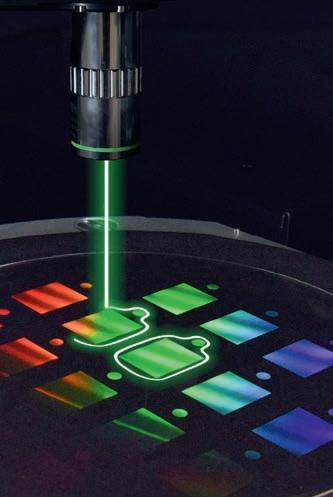

Advertisement
MAFO 2-24 33 WWW.3D-MICROMAC.COM Contact us: +49 371 40043-222 sales@3d-micromac.com microPOLAR Laser Processing System » Fully integrated options for eyepiece handling and quality inspection » Broad material range » Outstanding in-field upgradability: from R&D to volume production » Small machine footprint Cutting of AR Waveguides

AR and MR devices as the next computing platform
The current state of manufacturing technology
Augmented Reality (AR), Mixed Reality (MR), and Extended Reality (XR) have been on everyone's lips for some time. The first devices that came onto the market with AR or MR functions were mainly used in the industrial segment. Applications here were in online training, e-learning, and VR-supported maintenance but sales are still low due to the devices' bulky shape, heavyweight, and limited Field Of View (FOV). However, the next generation of devices is on the way. Those shall allow interaction between people and the digital universe – eyeglass-like with an integrated mini-computer. The strategic goal: AR and MR devices as the next computing platform. The expectations for the devices are high. Analysts compare the upcoming changes with those of the introduction of the first iPhone in 2007. By Mandy Gebhardt and Matthias Nestler
Smart Technologies
MAFO 2-24 34 TECHNOLOGY

There is no question that it is not just technology companies and specialty glass manufacturers dealing with the issue. Leading eye optics experts are investing in researching and developing new intelligent glass products that mix AR with ophthalmic functionalities. Integrating Virtual Reality (VR) and metaverse technologies sets a clear signal for the future: It is possible to interact with the environment via AR, such as quickly and easily accessing certain information, understanding another language, or being g uided from A to B by a virtual navigation system.
The simultaneous correction of ametropia opens up further exciting possibilities for many people to improve or recover the ability to see. However, before the successful market launch of AR devices, there are still a few hurdles to overcome. These arise from the technical challenges of AR/MR, the current state of manufacturing technology, and the increasing importance of the economic aspects.
Since AR and MR devices shall be produced in billions of units, the supply chain will be driven by cost efficiency. The threshold for market acceptance can only be overcome if the end product's price is affordable and attractive to the consumers. To achieve this, stable and cost-effective manufacturing processes with a high level of automation are required to guarantee a long service life and high reliability of the components.
The display - the core of each AR device
Among the most significant technological challenges associated with AR is the optical design of the device. To allow users to see the natural world and the virtual image in parallel, displays are integrated into the eyeglasses. The so-called optical combiner, which combines the real-world image with the virtual image generated by the display or projector, is at the heart of any AR device.
Already well-known to the industry for decades, such combiners have not been suitable for consumer all-day use, especially their form. Waveguide technology offers a potential solution: Flat substrates, made of optical grade glass, guide the image parallel to the waveguide's surface while simultaneously allowing light to pass through perpendicular to the waveguide's surface.
Thus, many performance-defining parameters depend on the waveguide material and its specifications, such as refractive index, specific density, transmittance, homogeneity, flatness, warpage, etc.
To fabricate lightweight near-eye displays, AR devices use optical waveguides with diffraction gratings to guide light from a display by Total Internal Reflection (TIR) into the human eye's view.
Figure 1 shows a scheme of the optical gratings used as light couplers. The small input grating diffracts the light coming from a light engine (or projector) into the eyeglass, acting as a waveguide.
The light is diffracted in the viewer's direction at the out-coupler grating. For uniform illumination of those out-coupling gratings, the structure depth increases with the traveled light distance in the waveguide, also named “leaky gratings.”
Different approaches exist for the design of coupling gratings. One type is the so-called Surface Relief Grating (SRG). Within this group, the gratings are classified into blazed gratings, binary gratings, analog gratings, and slanted surface relief gratings. Slanted gratings suppress higher diffraction orders and thus maximize the light yield. Variation of the slant angle is desirable to achieve a high FOV, but a certain challenge. In the following, the fabrication process of slanted SRGs will be shown.
Manufacturing of slanted surface relief gratings as a crucial component of the waveguide
Ion beam etching technologies are ideally suited for precise surface processing. All ion beam techniques are applied in a vacuum environment. The ion beam process combines physical and chemical etching.
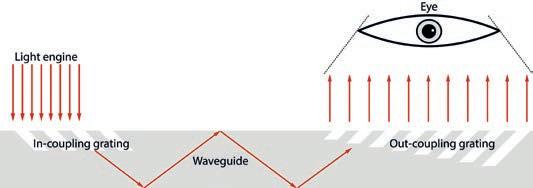
Smart Technologies
Fig. 1: Scheme of an optical grating that is used for coupling the light from the source into the waveguide glass and out of it towards the eye.
MAFO 2-24 35 TECHNOLOGY
Smart Technologies

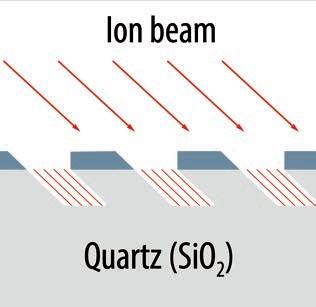
Physical etching uses the kinetic energy of fast inert ions bombarding the surface to sputter, releasing atoms from the target surface. That process is working on all materials facing the ion beam. Chemical etching utilizes a chemical reaction between the reactive ions and the target surface. The reaction products must, therefore, be volatile. The ion beam scans over the device surface. By varying the scan velocity, thus the dwell time, and the angle of incidence, the material removal can be adjusted precisely at each substrate location to achieve a perfect etching structure with superior homogeneity. It is possible to create many different geometries in a large spectrum of processable materials, including glass, SiO2, SiC, TiO2, etc.
Furthermore, ion beam processing is a contactless process that does not create any mechanical stress on the surface of the substrate, thus avoiding sub-surface damage. That makes ion beam processing the method of choice for low damage, high precision, and high uniformity for optical engineering.
Different ion beam technologies are used to produce slanted surface gratings depending on whether a constant or varying angle is required.
Reactive ion beam etching for processing SRGs with a constant slant angle and etching depth
In the first step, a resin mask or pattern on a glass substrate is created by photolithography. The mask will be used to structure an intermediate metal mask or the glass directly.
A full substrate processing by Reactive Ion Beam Etching (RIBE) is ideally suited to create surface relief gratings with constant slant angles.

Introducing reactive gases into the etching process makes it possible to control the selectivity of different surface materials and enhances the etch rate. The substrate can be tilted to etch slant angles as flat as 60 degrees (Fig. 2). On top of the substrate material is a chromium mask, which defines the grating structures (Fig. 3).
Crucial parameters for the RIBE process are the selectivity between mask and substrate and the geometry control of both the side wall and bottom angles. Using different etching gases can control the degree of anisotropic etching behavior, which finally defines the resulting geometry of the gratings (Fig. 4). Reactive gases can be introduced into the ion beam source. The ability to independently control ion energy and ion current is additionally used to adjust slant geometry and selectivity.
Another advantage of the RIBE process for manufacturing surface relief gratings is that a wide FOV is needed for the final AR product. The critical angle for total internal reflection limits the shallowest angle under which light may travel within the waveguide. The critical angle is smaller for high refractive index materials, and the FOV is bigger. That is why high-refractive materials with refractive indices >2 will not be etched with standard gases like those used for quartz etching but with adapted mixtures and recipes.
These unique capabilities to control gas mixture, ion energy and ion current, substrate angle, and even substrate temperature make RIBE the preferred technology for etching slanted relief gratings.
Reactive Ion Beam Trimming (RIBT)
for processing SRGs with varying slant angle and etching depth
Variation of the slant angle is desirable yet somewhat challenging to achieve a high FOV. Ion Beam Trimming (IBT), a well-established technique in the semiconductor industry to locally modify a given substrate's thickness to achieve a desired target topography, is ideally suited to create surface relief gratings with varying slant angles and

 Fig. 3: Scheme of an etched quartz grating.
Fig. 4: REM pictures of slanted relief gratings with a high aspect ratio, etched with an angle of incidence of 40° and different process recipies..
Fig. 5: REM pictures of slanted relief gratings with a small aspect ratio, etched with an angle of incidence of 20°(left) and 40°(right).
Fig. 3: Scheme of an etched quartz grating.
Fig. 4: REM pictures of slanted relief gratings with a high aspect ratio, etched with an angle of incidence of 40° and different process recipies..
Fig. 5: REM pictures of slanted relief gratings with a small aspect ratio, etched with an angle of incidence of 20°(left) and 40°(right).
MAFO 2-24 36 TECHNOLOGY
Fig. 2: Ion beam etching of gratings under different angles of incidence.
Smart Technologies

etch depths. IBT uses a focused broad beam of positively charged ions to etch material locally off the glass substrate by ion bombardment.
An ideal-shaped ion beam ensures a sufficient lateral resolution and a high throughput. The ion beam moves in a meander-shaped pattern across the substrate surface during trimming. It is possible to adjust the material removal precisely by altering the local dwell time.
Reactive Ion Beam Trimming (RIBT) has been adapted to fabricate surface relief gratings with varying slant angle and trench depth. The optically transparent substrate is covered with a hard mask providing the basic grating geometry such as period and duty cycle. Then, localized ion beam etching is applied to etch the trenches.
Varying the ion irradiation dose using dwell time variations sets the trench depth locally. The angle of incidence of the ion beam directly transfers into the substrate as the slant angle. It can be varied independently of the dwell time, providing the unique possibility of achieving a continuous variation of the slant angle across one die.
To avoid redeposition of the sputtered trench material to the grating side walls, additional reactive gases are added to the ion beam source. The plasma activation of the reactive gases leads to a chemical and physical etching of the substrate material, which helps to increase throughput, material selectivity, and trench angles of patterned surfaces.
The choice of the process parameters, e.g. process gas composition and ion energy, allows for tuning the selectivity between the hard mask and optical material such that high aspect ratio trenches are possible while keeping the hard mask thin. That avoids the shadowing of neighboring structural features.
Direct structuring of waveguides vs. structuring of master stamps
The slanted gratings can either be etched directly into the waveguide or into a master stamp (mold) that is used to produce the AR/MR display via nanoimprint lithography (NIL). For NIL, a master stamp is structured
by RIBE technology. Afterwards, the master stamp is pressed into a polymer spin-coated substrate to replicate the pattern.
However, polymers do not offer high-refractive indices as glass material can do, which has a disadvantage regarding the FOV of the final device.
scia Systems offers industrial-approved solutions to meet customers' demand for high-quality waveguide or master stamp patterning. The systems are used for coating, etching, and cleaning processes with nanometer resolution and have been successfully implemented in various high-tech industries worldwide, including microelectronics, MEMS, and precision optics industries.

Mandy Gebhardt
Mandy Gebhardt holds a diploma degree in Economic Computer Science from the University of Cooperative Education Glauchau. Since 2000, she worked in marketing and public relations in various high-tech companies, and since 2010, as Team Leader of Marketing/PR. In October 2023, Mandy joined scia Systems as the Head of Marketing.
scia Systems offers industrial-approved solutions for high-quality waveguide or master stamp patterning. The systems are used for coating, etching, and cleaning processes with nanometer resolution and have been successfully implemented in various high-tech industries worldwide.

Matthias Nestler holds a diploma degree in Physical Engineering from the West-Saxonian University of Applied Sciences Zwickau. After graduating in 2000, he worked as a project manager in a company specializing in ion beam and plasma process technologies. In 2004, Matthias took the product manager position in this technology field. After founding in 2013, he joined scia Systems as Director of Products and Technologies. Since then, he has been responsible for all product and process development activities.
Matthias Nestler
Fig. 6: scia Trim 200 – Ion beam trimming system for the production of slanted gratings on 200 mm wafers.
MAFO 2-24 37 TECHNOLOGY
◆

Risk management
strategic and structured
Smart investment in a crucial business competence
In a rapidly changing world, risk management is playing an increasingly important role. The skillful handling of unforeseeable dangers has long since gone from being a nice-to-have to a have-to-have. Identifying risks of a strategic business – legal or financial nature – at an early stage, determines whether control mechanisms take effect in good time and whether negative developments can be steered in a positive direction.
By Russell Kenrick and Sidra Sammi
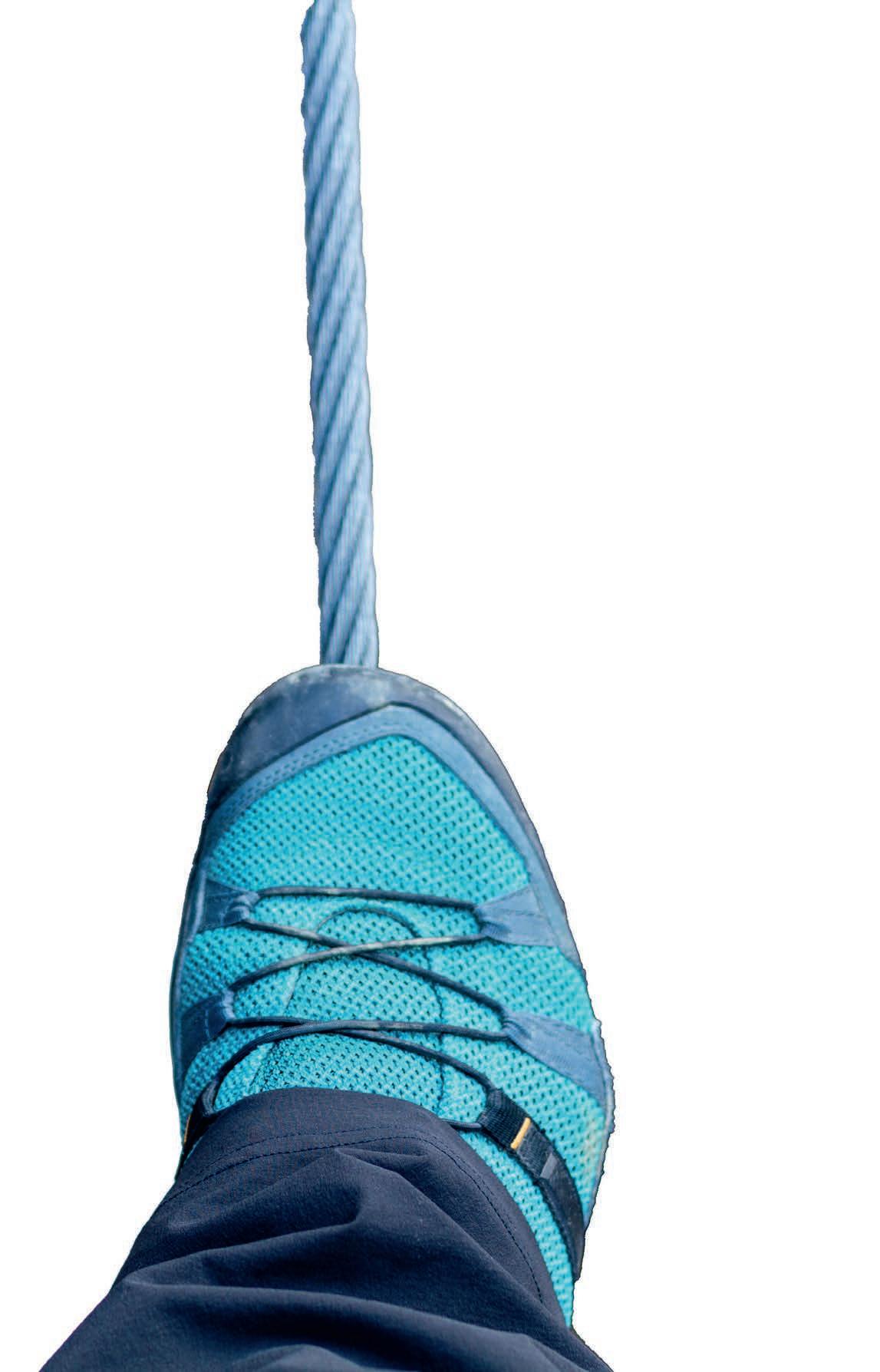
–
MAFO 2-24 38
We live in a VUCA world. The term was coined back in 1990, following the collapse of the Soviet Union and a new world order in which the environment had to be completely reassessed. VUCA was intended to bring clarity and stands for:
V = Volatility
U = Uncertainty
C = Complexity
A = Ambiguity
Today, more than 30 years later, these terms describe our modern (working) world better than ever. For example, if we know where uncertainties exist, we have the opportunity to consider what we can do about them in advance. And that brings us to the subject of risk management.
Attempt at a definition
Risk management refers to the systematic recording and assessment of risks to business operations. But that is by no means everything! It is not enough to record and evaluate risks, because that would only represent the current situation. Hence the second important point: risk management helps companies to identify operational, legal and procedural risks and mitigate them through preventive measures. But perhaps a risk can also be something positive, because it draws our attention to the fact that we can improve or increase something under certain conditions – provided the risk management process works.
Good risk management requires a systematic approach. The ISO 31000 :2018 standard, for example, sets out guidelines that describe how to deal with risks in an organization. The application of these guidelines can be adapted to each company in its specific environment. It always starts with the question: are we more concerned with projects or strategic planning or are we at the operational level? The latter would be, for example, a power outage that means a company can no longer produce.
The first important step in risk assessment is risk identification, followed by risk analysis (describing causes and effects) and finally risk evaluation. In addition to databases that incorporate empirical values from other companies, also internal risk identification workshops – in which creative techniques such as brainstorming/writing are used to find out what could happen – are particularly helpful for risk identification. Once we have identified and classified the risks, we have to decide what dangers they pose for our company.
This assessment gradually results in clear criteria for certain risks, including possible strategies and specific measures. At the same time, risk identification makes it possible to classify which risks we still have or permanently have, which have been newly added or have possibly even disappeared. Monitoring and reviewing risks always means making comparisons: is the assessment from last week or last month still correct? Or have certain parameters changed, which also changes the assessment?
When it comes to measures, it is important to check which ones are planned, can be implemented on time or whether the measures taken have already contributed to minimizing risk.
The elementary hazards in the company
The pandemic has taught us that everything can change from one day to the next. Nevertheless, this only has a limited impact on the topic. Legislation has long prescribed risk management in many areas. In addition to the obligation, however, there are companies that have shifted their focus on the topic as a result of their experiences with the pandemic. The shock is deep-seated and they want to be better prepared for possible future events of this kind.
Irrespective of this global problem, there are of course also smaller regional or industry-related incidents, including personal strokes of fate, which can be handled more easily and better with strategic risk management.
Let us take a look at possible examples of corporate risks: The German Federal Office for Information Security (BSI), for example, has listed 47 elementary threats for IT companies. The individual risk areas are presented in a document, together with recommendations on how to deal with them.
In principle, risks can be divided into different areas. In the case of external risks that affect the environment (laws, spatial conditions, etc.), we have little influence. We have to accept events as they happen and when they happen. Of course, we can prepare for laws in good time, for example, but we cannot prevent them.
In the case of internal risks, we normally have more influence on the probability of occurrence and, above all, on what and when we can do something about them.
Risk assessment = probability of occurrence + damage (+ time factor)
Once we as a company have collected all the risks, classified them and described the causes and effects, we can move on to risk assessment.
Two criteria are relevant here: firstly, the probability of occurrence and secondly, the extent of damage.
Finally, we have a third point that is sometimes neglected because it is not necessarily relevant for the assessment, but conversely is very important for the planning of measures: the proximity of occurrence, i.e. the time factor.
How we plan measures ultimately depends on whether we expect a risk to occur next week or a year from now. For the evaluation, however, we first stick to the combination of probability of occurrence and impact, which figure 1 (page 40) demonstrates wonderfully. Based on this, a risk matrix can be created/the risk value can be calculated.
When dealing with and handling risks, it always makes sense to consider how we as a company can use our strengths to avoid dangers or seize opportunities. If, on the other hand, weaknesses meet risks, this is usually far more challenging for companies.
MAFO 2-24 39 BUSINESS
Four strategies emerge from the created risk matrix. Risk avoidance is about avoiding the risk completely, if possible. Risk reduction is about lowering the probability of the risk occurring or reducing the scope (of the loss). In risk transfer, we do not bear the risk ourselves, but transfer it to a third party (example: factoring). The last option is risk acceptance, in which we – precisely – do nothing! At least for the moment.
Of course, it is also worth taking a look at the risks from time to time. We can then derive measures from these strategies – concrete activities that are planned and can be preventive or corrective. One example: If I know that the stairs in the stairwell have been wiped, they are slippery and I could slip and fall, I could place a mattress at the foot of the stairs as a corrective measure and fall on it, thus minimizing the risk of

Russell Kenrick, CEO of TSG Training and ILX Group, has worked in L&D for 15 years. His passion lies in the areas of personal development, data-driven decision making and learning technology, which are playing an increasingly important role in the transformation of organizations and workplaces. In addition to business growth, he is responsible for the training portfolio and career development of ILX employees.
Risk avoidance:
Avoiding risks completely. The hazard can no longer take effect.
Risk reduction:
To lower the probability of the risk occurring or to reduce the scope (the damage) if the risk occurs.
Risk transfer:
Not to bear the risk itself, but to transfer it to a participant
Risk acceptance:
Do nothing! At least for the moment. Take a look at the risks from time to time!
injury. A preventative measure would be to minimize the likelihood of slipping by waiting at the top of the stairs until they are dry.
Risk management is a very comprehensive topic and accordingly has a broad field of possible assessments and treatments of hazards in the company. The more experts you ask, the more opinions there are. A strategic and structured approach is always important in risk management. This requires awareness and well-trained employees. If companies strengthen their risk management expertise, the investment usually pays for itself more quickly than expected. Human error or machine failure, the VUCA world or many small everyday hazards – all of these can be mastered. With identify, assess, measure, unforeseeable risks are now a thing of the past!

Sidra Sammi is responsible for business development DACH at ILX Group. Her strength lies in identifying specific challenges in organizations and presenting tailor-made solutions. In her previous role as Territory Manager for the European markets at Axelos, she acted as a single point of contact for organizations using best practice methodologies such as PRINCE2, ITIL and PRINCE2 Agile.
Sidra Sammi
Russell Kenrick
Effects/amount of damage Existence- threatening Medium HighVery highVery high Considerable MediumMedium HighVery high Limited Low Low Medium High Negligible Low Low Low Low Rare MediumFrequentlyVery often Frequency of occurrence Transfer Avoidance Acceptance Reduction
MAFO 2-24 40 BUSINESS
Fig.1: Risk matrix

Why Choose MAFO
Expertise: Our team comprises ophthalmic optics specialists
Global Insights: We connect professionals worldwide
Comprehensive Coverage: From articles to market analysis
Timely Updates: Stay informed in a fast-paced industry
VISIT US ONLINE NOW: WWW.MAFO-OPTICS.COM VISIT THE NEW WEBSITE YOUR TRUSTED SOURCE IN OPHTHALMIC OPTICS
OPHTHALMIC LABS & IN DUSTRY
Features
Special features - machine
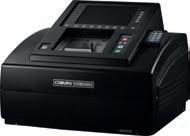

Small and medium size labs Medium sized labs, mass production labs

Small labs, medium sized labs mass production labs
Standard: up to 09 – Special: up to 16 (possible limitations based on real front radius, thickness , shape and decentration. )
Standard: up to 09 – Special: up to 16 (possible limitations based on real front radius, thickness , shape and decentration. )
With automatic loading
With automatic loading 1500 / 3307
/ /
x
x
x
Total Quality Control, Final Inspection 4QC, 4 working & 4 inspection stations, Glide Meter, Silver Polishing, Automatic Calibration, Double Drive system
Process 4 lenses at the same time, Total Quality Control, 2 Independent Edging stations with 2 spindle each, high versatility with the tool changing system, automatic calibration, Double Drive system, Ionizers to help the scraps evacuation
Drilling / x x
Grooving x x x
Polishing x x x
Bevelling options
Bevelled, grooved, and flat-edge Step bevelling / T-bevelling/ Bevelling according to a specific curve / Safety bevel
V-Bevel angle / 115° standard (100° optional)
Hybrid finishing (e.g. groove on bevel) / Partial bevelling / double grooving / partial step back
Design finishing / x x
Engraving / / o
Lens inspection (E.g. Shapes detection, power, axis ….) / Power & axis inspection, Polarization, Gradient, Blank Cut-Out Auto Correction
Automatic laser engravings detection / Progressives, single vision FF, Edge Process Engravings
Special features
Info Further information
Advanced 3D digital technology, automatic polishing of beveled, grooved, and flat-edged lenses, automatic front and rear safety beveling, four grinding wheels for multiple lens materials.
Remote access, data supervision, productivity analysis, temperature stabilizer, central thickness verification
Remote access, data supervision, productivity analysis, calibration free design to save time when changing components
x = yes; / = no; o = option Industrial Edging Coburn Technologies MEI System www.coburntechnologies.com www.meisystem.com
Perfecto Lens Edger 4Racer TBA Swift Bisphera TBA Phoenix Application
Application field
Lens materials
CR39,
Lens diameter minimum [mm] 18,5 20 20 Lens diameter maximum [mm] 90 85 85 Maximum base curve [dpt] 8
CR39, Polycarbonate, Trivex, Tribrid, High Index CR39, Hi-Index, Polycarbonate, Trivex, Tribrid
Hi-Index, Polycarbonate, Trivex, Tribrid
Technical data Productivity [Ø lenses per hour] 26 up to 200 up to 160 Dimensions [w x d x h] (mm / inch) (Machine without conveyor) 661 x 711 x 661 26 x 28 x 26
1400 x 2555 x 2380 / 55.1 x 100.6 x 93.7
With automatic loading
1900
81
Weight [kg / lbs] 55 / 120
x
Milling
Dry edging / x
Automatic lens loading/ unloading / x
/ x
On-the-block x
Blockless / x
x 2400 x 2350(h) /
x 107 x 93(h)
Process Grinding
/ x
x Fully automated
/ /
x
MAFO 2-24 42 MARKET SURVEYS


Small labs, medium sized labs, mass production labs
CR39,
With automatic loading
Manage two jobs per time, quality control, automatic calibration, Double Drive system
Power &
Remote access, data supervision, productivity analysis

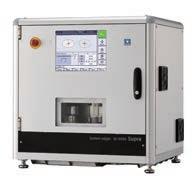
Small and medium-sized labs
CR39, Polycarbonat, Trivex, Tribrid, High Index Plastic,
Automatic calibration, Double Drive system, Immediate lens placement with the integrated lensometer, load right and left lenses at once and wait for the complete process, Total Quality Control
CR-39, High Index Plastic: 44 Polycarbonat, Trivex, Tribrid, Acrylic
Compact automation system with optional robot unit
Remote access, data supervision, user-friendly interface, active carbon filter
High quality polish and polish safety bevelling
Faster grinding with dual spindle system. No need for a large capacity air compressor and vacuum unit
MEI System Nidek www.meisystem.com www.nidek.com MEI 641 TBA EzFit TBA EasyFit Trend SE-9090
Supra
Hi-Index,
Polycarbonate, Trivex, Tribrid
Acrylic
18 20 20 18 90 90 90 100 Standard: up to 09 – Special: up to 16 (possible limitations based on real front radius, thickness, shape and decentration) 10 up to 58 up to 50 up to 55
Resin
Resin: 22
1665 x 1405 x 2020 / 65.5 x 55.3 x 79.5
987 x 1484 x 2208 / 38.8 x 58.4 x 86.9 With manual
770 x 1000 x 1775(h) / 31 x 39 x 70(h) 600 x 517 x 611
loading 975
2150With
loading 650
1433With manual loading 450
992 118
260 / / / x x x x / x x x / x x Fully automated with EasyBuddy accessory o x x o / / / / x x x /
With automatic loading
loading
With automatic
/
automatic
/
/
/
x x x o x x x x x x x x Step bevelling / T-bevelling / Bevelling according to a specific curve/ Safety bevel Step bevelling, Safety bevelling 115° standard (100° optional) 110° Partial bevelling / double grooving / partial step back / x x x o o o o /
Cut-Out Auto Correction Power & axis inspection, Shapes
holes detection, Gradient, Blank CutOut Auto Correction o
axis inspection, Polarization, Gradient, Blank
and
Progressives, single vision FF, Edge Process Engravings /
MAFO 2-24 43 MARKET SURVEYS
Special features - machine
Grooving
Bevelling options
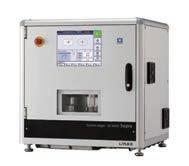
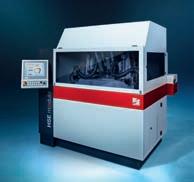
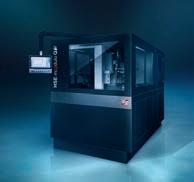
Compact automation system with optional robot unit
2 independent edging stations. Highest flexibility for complex shapes
4 independent processing stations for highest throughput
Vertical and inclined bevels (w or w/o polish) groove, rimless (w or w/o polish)
Safety bevelling
safety bevel, t-bevel, step back, design cuts, combinations of bevel types
Built-in quality control - Rx power, axis, prism, polar axis, cutout check, power map (full lens inspection)
Automatic laser engravings detection / x x
Special features
Possible to grind mineral lens (Dependend on wheel type)
Faster grinding with dual spindle system.
No need for a large capacity air compressor and vacuum unit
Full lens inspection incl. power map; modulo system integrable; control center ready
Full lens inspection incl. power map; post edging check; modulo system integrable; control center ready
x = yes; / = no; o = option
Nidek Schneider www.nidek.com www.schneider-om.com
Supra L HSE Modulo HSE Modulo QS Application
field
and medium-sized
production Lens materials Mineral, CR39, Polycarbonat, Trivex, Tribrid, High Index Plastic, Acrylic Resin CR39, Polycarbonat, Trivex, Tribrid, High Index, Acrylic Lens diameter minimum [mm] 18 24 24 Lens diameter maximum [mm] 100 100 100 Maximum base curve [dpt] 10 up to 16 Technical data Productivity [Ø lenses per hour] CR-39, High Index Plastic: 44 Polycarbonat, Trivex, Tribrid, Acrylic Resin: 22 Mineral: 20 up to 120 up to 220 Dimensions [w x d x h] (mm / inch) (Machine without conveyor) 600 x 517 x 611 2055 x 1610 x 2110 1650 x 2950 x 2225 Weight [kg / lbs] 118 / 260 1650 / 3638 2750 / 6063 Process Grinding x / / Milling / x x Dry edging / x x Automatic lens loading/ unloading o x x Fully automated o x x On-the-block / o / Blockless / o x
Industrial Edging
SE-9090
Application
Small
labs Medium sized labs Medium sized labs, mass
o
Features Drilling
x x
o x
Polishing x x
x
x
V-Bevel angle 110° 100° - 120° 100° - 120° Hybrid finishing (e.g. groove on bevel) / x x
finishing o x x
Design
Engraving / / /
(E.g. Shapes detection,
axis
o
Lens inspection
power,
….)
Info Further information
MAFO 2-24 44 MARKET SURVEYS



















HARD COAT LEADER 271 rue Laszlo Biro Archparc FR-74160 Archamps Phone : +33 (0) 450 820 720 Email : office1@scl-intl.com scl-intl.com HARD COATING CLEANING TINTING CONSUMABLES EXPERTISE Cleaningad: World leaders in Lens Hard Coating Machines and process solutions Full range available for any production volume Expert advice on your application World leaders in Ultrasonic Cleaning Machinesprior to lens coating Full range available for any lens volume Expert advice on your application Contactusfor our full range: +44 (0) 1462491616 sales@optimal-technologies.com www.optimal-technologies.com sales@optimal-technologies.com optimal-technologies.com contact us: (+44) 1462 49 16 16 optics@fisa.com www.fisa.com Pub FISA - Optical World 88x40.indd 1 14/12/2021 16:49 Cleaning and hard coating equipment Suppliers Guide The Suppliers Guide is MAFO’s version of Yellow Pages. In it you can find an overview of suppliers from the fields of: ▶ cleaning and hard coating equipment ▶ coating equipment ▶ crystals ▶ laser engraving & printing ▶ lens surfacing machinery ▶ lenses ▶ machinery – automation, control & packaging ▶ machinery – lens edging & industrial edging ▶ software ▶ surfacing and finishing consumables If you are interested in an entry in the Suppliers Guide, please contact Mrs. Classen: constanze.classen@mafo-optics.com Bühler Alzenau GmbH Business Area Leybold Optics Siemensstrasse 88, D-63755 Alzenau T + 49 (0) 6023 500-0, F + 49 (0) 6023 500-150 leyboldoptics@buhlergroup.com www.buhlergroup.com Coating equipment UV Curable Hard Coat Adhesion On All Lenses Tintable Non-Solvent Based AR Coating Compatible Sales, Distributors Wanted Shipping Worldwide www.hcoating.com sales@hcoating.com QUALITY & SAVINGS FROM STOCK QUALITY & SAVINGS FROM STOCK QUALITY & SAVINGS FROM STOCK paula@filtech.com • Sensor Heads and Feedthroughs • INFICON Deposition Monitors and Controllers • Quality Crystals® • Vacuum Pump Fluids • Vacuum Measurement Gauges • Electron Beam Gun Parts • Ion Source Parts 617-227-1133 • 800-743-1743 www.filtech.com Crystals MAFO 2-24 45

































































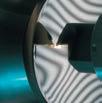


















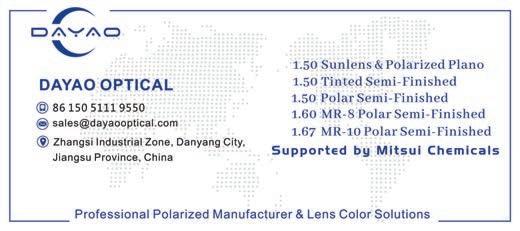
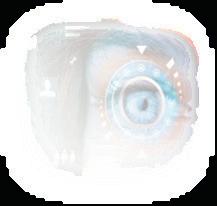

Lenses OPTICAL MANUFACTURING SOLUTIONS Satisloh AG Neuhofstrasse 12 CH - 6340 Baar / Switzerland Phone: +41 (0) 41766 16 16 Email: info@satisloh.com satisloh.com !AZ.indd 9 Optical Machinery. Processing Technology. OptoTech Optikmaschinen GmbH Sandusweg 2-4 • 35435 Wettenberg/Germany Tel.: + 49 641/98203-0 eMail: info.de@optotech.net Web: www.optotech.net SCHNEIDER GmbH & Co. KG Biegenstrasse 8–12 · 35112 Fronhausen · Germany Phone: +49 (64 26) 96 96-0 · Fax: +49 (64 26) 96 96-100 www.schneider-om.com · info@schneider-om.com !AZ.indd 2 Lens surfacing machinery Lens surfacing machinery Enjoy, • unlimited designs • digi-speed process www.tecofrance.com info@tecofrance.com Choose your frame colour White Green Blue Red Cyan Purple X-Cube Lens Digi-speed Printer PUB_TECO-Juillet 2016.indd 1 25/07/16 17:59 26.07.16 14:56 Laser engraving & printing Premium-Quality Laser Engraving of Spectacle & Contact Lenses Industry approved since 2004 www.ophthalmic-marking.com 30.11.20 12:42 Suppliers Guide Machinery - Automation, Control & Packaging Lens Quality Control Automation Process Control Services & Solutions BELGIUM - THAILAND - USA - LATIN AMERICA www.ar.be MAFO 2-24 46
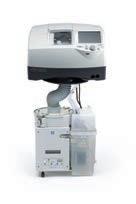


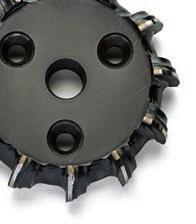




Software Surfacing and finishing consumables Surfacing and finishing consumables The Lab Management System Company LensWare International GmbH Robert-Bosch-Str. 32 63225 Langen - Germany Phone : +49 6103 / 372 87 87 Email : info@lensware.de Web : www.lensware.de Your lens design and innovation experts IOT exists to empower independent labs and ECPs to create the best lenses in the world. 20 avenue Reille - 75014 PARIS - FRANCE T l. : +33 (0)1 45 89 84 44 - Fax : +33 (0)1 45 89 66 54 contact@agp-abrasifs.com - www.agp-abrasifs.com GENERATING POLISHING EDGING Machinery - lens edging & industrial edging www.nidek.com info@nidek.co.jp Combination of dynamic ideas and stable performance provides superb Lens Edging 18.04.23 09:35 Suppliers Guide Find out more: mafo-optics.com SAMPLE incl. presence in the MAFO online Suppliers Guide 1 module (88 x 40 mm) per year with company logo 4c = € 990 p.a. Contact: constanze.classen@mafo-optics.com YOUR ULTRA PRECISION Diamond Tools Manufacturer > Compliant with any generator > Excellent service and quick turnaround ky diamond.ca sales @ kydiamond.ca !AZ.indd 3 !AZ.indd 6 TECHNOLOGY AT IT’S BEST –FOR OPHTHALMIC LABS & INDUSTRY OPHTHALMIC LABS & INDUSTRY HOME OF YOUR BUSINESS SG_Eyepress.indd 1 30.01.20 16:41 MAFO 2-24 47

Carla Moncunill Cabré
A sports enthusiast with technical know-how
Carla Moncunill Cabré is Group Sales Responsible at Coburn Technologies for the south Europe area. She is based in Montserrat a region near Barcelona, Catalonia in Spain. Carla is a commercial responsible with a deep technical expertise, as she was graduated in mechanical engineering and she has a master in industrial plants direction and lean manufacturing. Both degrees are from the Polytechnic university of Barcelona (UPC). Previously to her current position she worked as quality manager in the automotive industry and in the project management in architectural projects involving metal meshes. But the 32-years-old is also a very passionate mountaineer and sports enthusiast with a love for running, skiing, climbing, and cycling. Furthermore, the all-round talent loves reading novels and traveling around the world.
If you could change one thing in the world, what would that be?
If I could change one thing in the world, it would be to foster greater environmental consciousness and action to preserve our planet's natural beauty and resources for future generations.
In your opinion, which movie/book should everyone have seen/read?
In my opinion, everyone should experience the profound storytelling and thought-provoking themes of “Into the Wild” by Jon Krakauer. It's a captivating exploration of self-discovery and the allure of the wilderness.
Which celebrity – past or present – would you most like to meet personally, and why?
Marie Curie. Her contributions to science have had a profound impact on our understanding of the natural world. Meeting her would offer a unique opportunity to gain insights into her scientific discoveries and the challenges she faced as a trailblazing woman in a male-dominated field.
What is your favorite place in the world?
I think the earth is a very beautiful place to choose just one place! But for me, Montserrat is my daily place of tranquillity, special and magic.
What was the last event that deeply moved you?
The death of a loved one.
Which profession did your parents have in mind for you?
My parents have always told me: “Whatever you do, do it with passion. If you don't live something, you won't be able to do it well.”
If you didn´t do your current job, what else would you do?
Maybe I would likely pursue a career in environmental conservation or helping others.
What is the best thing about your job?
The best thing about my job is the opportunity to connect with people from diverse backgrounds and cultures, and contributing to the advancement of optical technology.
When was the last time you were fed up with your job?
I can't recall a specific instance of being fed up with my job recently. Every challenge presents an opportunity for growth and learning, which keeps me motivated and engaged.
What does a new customer mean to you?
A new customer represents a new relation, an exciting opportunity to grow and learn together.
What has annoyed you today?
The typical telephone answering machine where a robot speaks and then they play the music while you are waiting. I hate them!
In your opinion: which thing is completely overrated?
The relentless pursuit of material possessions.
What was the most significant innovation of the last fifty years?
Internet of course! Revolutionizing communication, access to information, and virtually every aspect of modern life.
What would you do differently in your next life?
Play an instrument. And I would choose the piano.
MAFO 2-24 48 CLOSING WORDS

Closing with good news!
Contact lens detects changes in intraocular pressure
Scientists from United Kingdom and Turkey have developed a contact lens that can detect changes in intraocular pressure and can therefore provide an indication of whether there is a risk of glaucoma. Around 70 million people worldwide are affected by glaucoma, which can lead to irreversible loss of vision if left untreated ‒ and unfortunately around half of those affected are unaware of it.
The new contact lenses contain microsensors that monitor changes in intraocular pressure over a period of several hours. The data collected can be transmitted wirelessly so that it can be analyzed and diagnosed by an ophthalmologist.
The research was conducted by Prof. Hamdi Torun from Northumbria University, Newcastle, United Kingdom, Prof. Günhan Dündar and Prof. Arda D. Yalcinkaya from Boğaziçi University in Istanbul, Turkey. The results of the first pilot study with six participants were published in the British Contact Lens Association journal “Contact Lens and Anterior Eye”.
Now that the scientists have established that the technology works successfully, they are planning a further study with a larger group of participants. The lenses will then be made commercially available through their spin-off company GlakoLens.
Special topics in MAFO 2024 Preview MAFO 03/2024

The special topic of the upcoming issue is “Lab Management”.
You will learn more about leadership skills, working conditions but also about current debates like the status on the subject of PFAS (per- and polyfluorinated chemicals).
Further topics of this issue are the design of myopia management lenses, tested in Europe, data and the market survey Generators.
MAFO 2-24 49 OUTLOOK
MAFO 03 Future Lab MAFO 01 MAFO 05 Go Digital! MAFO 02 Smart Technologies MAFO 04 Go Green! MAFO 06 Markets Worldwide Lab Management



PUBLISHERS ADDRESS
Eyepress Fachmedien GmbH
Saarner Str. 151, D-45479 Muelheim a. d. Ruhr
Tel.: +49-208-306683-00
Fax: +49-208-306683-99
Website: www.mafo-optics.com
E-mail: info@mafo-optics.com
CEO Petros Sioutis
E-mail: p.sioutis@eyepress.de
PUBLISHER
Silke Sage, Petros Sioutis, Efstathios Efthimiadis
FOUNDED 2003 by Jörg Spangemacher
BANK DETAILS
Bank account: Sparkasse Aachen
Bank No.: 390 500 00, Acc. No.: 1073 3925 06
IBAN: DE21 3905 0000 1073 3925 06
SWIFT: AACSDE33XXX
CHIEF-EDITOR
Hanna Diewald
E-mail: hanna.diewald@mafo-optics.com
EDITORS
Rebekka Nurkanovic
E-mail: rebekka.nurkanovic@mafo-optics.com
Britta Laupichler
E-mail: britta@mafo-optics.com
TRANSLATIONS
John Saniter, Bopfingen
EDITORIAL BOARD
Jörg Spangemacher, Peter Baumbach, Mo Jalie





































PRODUCTION & LAYOUT
Efstathios Efthimiadis, Pascal Bruns
E-mail: production@eyepress.de
DISTRIBUTION
PressUp GmbH, Postbox 70 13 11, D-22013 Hamburg
Tel.: +49-40-386666-308, Fax: +49-40-386666-299
MEDIA CONSULTANT
Constanze Classen
Tel.: +49-208-306683-20
E-mail: constanze.classen@mafo-optics.com
ADVERTISING AGENT GREAT CHINA
Beijing FOCUS Optics Culture Communication Co. Ltd. Room 319, Building 2, Nr. 1, Northbank 1292, Nr. 15
J ianguo Eastroad, Beijing 100024 (Chaoyang), P.R. China
Mrs. Jian Wang
Tel.: +86-10-8537-6529
Email: jennywang_focus@126.com
Skype: jennywang611
焦点视光(北京)文化传播有限公司
北京市朝阳区建国东路15号院甲一号北岸1292 二号楼319室 邮编:100024
电话:+86-10-8537-6529
电邮:jennywang_focus@126.com
ADVERTISEMENT RATES
Price list no. 20, valid from January 01, 2024
Publication schedule
6 issues 2024: January, March, May, July, September, November







SUBSCRIPTION COSTS PER YEAR
European Union € 1 40,00
(plus VAT for German companies)
Overseas Seamail € 160,00
Overseas Airmail € 195,00
United States Seamail € 170,00
United States Airmail € 2 25,00
Single issue € 20,00
(plus mailing costs)
The Publisher requires three months written notice on cancellation. Subscribers please note that proof of notice may be required.
PHOTO CREDITS
P.28: Finde Zukunft, P.34: dragonstock, P.38: Tröbi, P.49: jd-photodesign, zinkevych /stock.adobe.com, /unsplash.com
PRODUCTION & PRINT
Kollin Medien GmbH, Neudrossenfeld, Germany
The publisher takes no responsibility for unsolicited manuscripts. Please note also that photographs submitted for use in MAFO cannot be returned. The publisher’s written permission is required for any reproduction, translation or recording of material published in MAFO, including extracts of such material. Permission will normally be given, subject to the usual acknowledgement. Copies made of published items must be limited i n number and for personal use only.

4/2023 Special topic: Data Handling & Security learning algorithms Highest level of lens personalization thanks to “big data” and recent scientific findings SLUGFest 2023 — and visions for the future Leica Eyecare — back to its roots Market Survey Dip- and spin hard coating machines Volume 19 OPHTHALMIC LABS & INDUSTRY Germany We help you to stay in contact ALL-INImagine one single machine featuring all the technology to surface 80 lenses/hour, in just 72 sq. t. (7m²). This is Modulo Center ONE. The compact all-in-one surfacing a milling station // a lathe turning station // one or two 4-spindle polishing units // a CO₂ or excimer laser. reliable components proven in hundreds of installations across the globe. The all-in-one surfacing center substantially saves time, running all processes simultaneously and perfectly synchronized – even milling and lathe turning. And with the chambers placed right next to one another, the smart automation transfers the lenses The dedicated Control Center (MES) informs at glance about the current status of the Labs can now run larger scale productions even in small locations and under nonindustrial conditions. Little to no operator intervention is needed as the center works fully automated with all essential components on board. Simply put: Blank in, surfaced lens out. M dulo Center 1 72 sq.ft. 80 4 1/2024 Special topic: Future Lab Digitalization and the Internet of Things optical coatings Technology Prismatic lenses for visually impaired people Smart Glasses: visit to the open Interview Mido 2024: “We feel responsible to make culture!” Spotlight Ray-Ban Meta glasses: What can they do, and what not? Market Survey Cleaning machinery Volume 20 OPHTHALMIC LABS & INDUSTRY Germany Connect, discover, stay up-to-date With DBX Modulo ONE, SCHNEIDER debuts powerful and fully automated new lens deboxer for high throughput, 24/7. The innovative technology unpacks all common kinds of boxes and materials – cardboard, blisters, even sleeves After swiftly identifying the type of box, DBX Modulo ONE opens it “naturally”: It unfolds, takes out and unwraps, entirely without touching the lens surface. SCHNEIDER‘s eco-friendly process avoids cutting or burning the material using sharp blades or high energy lasers no cutting particles or dust and no fumes. All waste material is separated and collected individually to simplify recycling and further increase sustainability. DBX Modulo ONE follows SCHNEIDER‘s vision to provide the full solution for ophthalmic labs, from warehousing all the way to inline coating and beyond. Ophthalmic lens production fully-automated and entirely hands-free. SEE IT LIVE AT MIDO // 03. – 05. February 2024 // Hall 6 // Booth T32 DBX m dulo Environmentally friendly Unboxing any kind of box THE NATURAL WAY OF DEBOXING 6/2023 Special topic: Go Digital! Lens production going digital AI´s ‒- a new language for the industry Technology Overcoming the gas age A breath of future at VEW 2023 Silmo Paris 2023 Market Survey Lens printing Laser engraving systems Volume 19 OPHTHALMIC LABS & INDUSTRY Germany Connect, discover, stay up-to-date VFT-ORBIT-2 MAXIMUM PERFORMANCE MEETS AI TRULY SMART LENS GENERATING Witness what happens when unmatched lens generator performance ultra-fast milling, voice coil technology & auto-calibration meets the power of AI in the new VFT-orbit-2i. With the seamless integration of Artificial Intelligence & Machine Learning, we´re revolutionizing ease with advanced diagnostics and predictive maintenance. Contact us for more details on VFT-orbit-2i! Minimizes unexpected break- Delivers diagnostic data to MES-360 Lite included to 5/2023 Special topic: Sustainable Processes A broad vision of sustainability all‒, only raw materials!” Technology Anti-reflex coating and process control Thickness and weight of ophthalmic lenses One drop and you regain the vision of a 20-year-old? Market Survey AR-Coating machinery Volume 19 OPHTHALMIC LABS & INDUSTRY Germany Connect, discover, stay up-to-date With DBX Modulo ONE, SCHNEIDER debuts powerful and fully automated new lens deboxer for high throughput, 24/7. The innovative technology unpacks all common kinds of boxes and materials – cardboard, blisters, even sleeves After swiftly identifying the type of box, DBX Modulo ONE opens it “naturally”: unfolds, takes out and unwraps, entirely without touching the lens surface. SCHNEIDERs eco-friendly process avoids cutting or burning the material using sharp blades or high energy lasers – no cutting particles or dust and no fumes. All waste material is separated and collected individually to simplify recycling and further increase sustainability. DBX Modulo ONE follows SCHNEIDERs vision to provide the full solution for ophthalmic labs, from warehousing all the way to inline coating and beyond. Ophthalmic lens production fully-automated and entirely hands-free. DBX m dulo Environmentally friendly Unboxing any kind of box THE NATURAL WAY OF DEBOXING Missed an issue? No problem, view the latest issues online: app.mafo-optics.com
MAFO 2-24 50
MASTHEAD


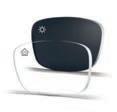





















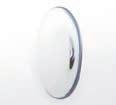




























































 François-Charles Laberge and Hugh McAllister from K&Y Diamonds.
The Ocuco booth attracted many visitors.
Jared Snow and Christian Tuss from Satisloh in front of NEO-edge.
The FISA-team at their booth f.l.t.r.: Matteo Rasi, Bernat Casaramona, Francesco Bertoja, Philippe Vaudeleau, Riccardo Strizzi
The company Ultra Optics presented their fully automated spin coating machine 54R.
François-Charles Laberge and Hugh McAllister from K&Y Diamonds.
The Ocuco booth attracted many visitors.
Jared Snow and Christian Tuss from Satisloh in front of NEO-edge.
The FISA-team at their booth f.l.t.r.: Matteo Rasi, Bernat Casaramona, Francesco Bertoja, Philippe Vaudeleau, Riccardo Strizzi
The company Ultra Optics presented their fully automated spin coating machine 54R.






 The General Optics booth in Hall 6.
Rupert Katritzky from the RAX Group in front of a storage solution for spectacle lenses.
F.l.t.r.: Thomas Zangerle, Sandra Fonticoli and Laurent Provost in front of the automated lens inspection NeoMapper.
At the teco-booth visitors could experience the new X-CUBE DECO to print permanent logos.
The General Optics booth in Hall 6.
Rupert Katritzky from the RAX Group in front of a storage solution for spectacle lenses.
F.l.t.r.: Thomas Zangerle, Sandra Fonticoli and Laurent Provost in front of the automated lens inspection NeoMapper.
At the teco-booth visitors could experience the new X-CUBE DECO to print permanent logos.













 Fig. 3: Smart systems rely on built-in intelligence and communication to manage the production flow more efficiently than any pre-planned model..
Fig. 3: Smart systems rely on built-in intelligence and communication to manage the production flow more efficiently than any pre-planned model..
























 Fig. 1: Progressive smart glasses by Morrow feature a user-friendly interface with simple touch-button control.
Fig. 1: Progressive smart glasses by Morrow feature a user-friendly interface with simple touch-button control.




 Lena Petzold
Lena Petzold









 Fig. 3: Scheme of an etched quartz grating.
Fig. 4: REM pictures of slanted relief gratings with a high aspect ratio, etched with an angle of incidence of 40° and different process recipies..
Fig. 5: REM pictures of slanted relief gratings with a small aspect ratio, etched with an angle of incidence of 20°(left) and 40°(right).
Fig. 3: Scheme of an etched quartz grating.
Fig. 4: REM pictures of slanted relief gratings with a high aspect ratio, etched with an angle of incidence of 40° and different process recipies..
Fig. 5: REM pictures of slanted relief gratings with a small aspect ratio, etched with an angle of incidence of 20°(left) and 40°(right).











































































































